THE PULTENEY STREET SURVEY
HOBART SKATES TO NATIONAL TITLE

With Flying Colors
To celebrate the last day of classes, Theta Delta Chi organized a Color Run to benefit the Doug Flutie Jr. Foundation for Autism.



To celebrate the last day of classes, Theta Delta Chi organized a Color Run to benefit the Doug Flutie Jr. Foundation for Autism.

all members
community, including

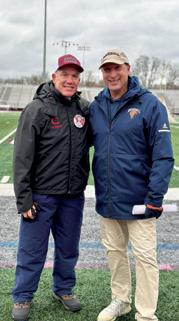
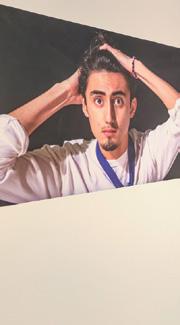
faculty, staff, volunteers, and visitors. HWS prohibits discrimination and harassment in their programs and activities on the basis of age, color, disability, domestic violence, victim status, gender, gender expression, gender identity, genetic information, national origin, race, creed, religion, sex, sexual orientation, marital status, veteran status, or any other status protected under the law. Discrimination on the basis of sex includes sexual harassment, sexual violence, sexual assault, other forms of sexual misconduct including stalking and intimate partner violence, and gender-based harassment that does not involve conduct of a sexual nature.

EDITOR, VICE PRESIDENT FOR MARKETING AND COMMUNICATIONS Catherine Williams / SENIOR MANAGING EDITOR Andrew Wickenden ’09 / DESIGNER Lilly Pereira / aldeia.design / CONTRIBUTING WRITERS/EDITORS Paige Cooke, Ken DeBolt, Hank Holden ’63, P’84, P’89, GP’20, Mackenzie Larsen ’12, Janice Leary, Mary LeClair, Colin Spencer ’19, Natalia St. Lawrence ’16, Jackie Swift, Mary Warner ’21, Andrew Wickenden ’09 and Catherine Williams / Additional content reprinted with the permission of American College of Emergency Physicians CONTRIBUTING PHOTOGRAPHERS Kevin Colton L.H.D. ’23, Adam Farid ’20, Elodie Heckimian-Brogan ’26, Brett Williams / Additional images courtesy of Adobe Stock, BreakingTheWalls/Getty Images, Jinitzail Hernandez/Shutterstock, Hobart and William Smith Colleges Archives / PORTRAIT ILLUSTRATOR Kathryn Rathke / PRESIDENT Mark D. Gearan / THE BOARD OF TRUSTEES CHAIR Craig R. Stine ’81, P’17 / VICE CHAIR OF THE BOARD OF TRUSTEES Cassandra Naylor Brooks ’89 / VICE PRESIDENT FOR ADVANCEMENT Robert B. O’Connor P’22, P’23 / William Smith Alumnae Association Officers: Katharine Strouse Canada ’98, President; Roxanne Jackson ’81, Vice President; Kirra Henick-Kling Guard ’08, MAT ’09, Immediate Past President; Amanda E. Shaw ’11, Historian / Hobart Alumni Association Officers: Paul Wasmund ’07, President; Mark A. Darden III ’87, P’17, Vice President; the Hon. Ludwig P. Gaines ’88, Immediate Past President; Andrew Donovan ’12, Historian. / For questions and comments about the magazine or to submit a story idea, please e-mail Andrew Wickenden ’09 at wickenden@hws.edu.
After an eventful spring, summer has reached Geneva. Mary and I were thrilled to see so many alums, families and friends on campus just a few weeks ago to celebrate Commencement and Reunion. Indeed, it has been a year of celebrations with the Bicentennial Gala; the Hobart hockey team’s historic national championship; the opening of the Adams Intercultural Center; multiple academic accolades for our graduating seniors including a Fulbright, Princeton-in-Asia, and five heading around the world for the Peace Corps; and still others embarking on new career paths, graduate programs and community service roles. And as I write this note to you, the Colleges are on track to record the second largest philanthropic year in our history with more than $35M in gifts and commitments.
This fall, we look forward to welcoming a new cohort of students to Hobart and William Smith, the largest incoming class in five years. The Classes of 2027 will arrive on campus to find a community ready to support and challenge them, with engaging academic opportunities such as our new major in Management and Entrepreneurship (p. 6) and the Institute for Global Studies, which serves as the home for nine internationally focused departments and programs.
As you will read in this issue (p. 32), faculty members developed the Institute for Global Studies to provide a unified center for enhancing interdisciplinary opportunities while preparing students to thinking critically and act boldly in an increasingly interconnected world. This new academic umbrella harnesses so much of what we value and excel at as a community: innovative and collaborative coursework; clear connections between classroom learning, off-campus study and future careers; and global thinking that has profound, tangible local impacts. Likewise, the alums profiled in this issue exemplify the interdisciplinary leadership that is shaping today’s world (p. 36).
This issue also features the Statesmen’s success on the ice, telling the story of their extraordinary 2022-23 season that culminated with the NCAA DIII National Championship (p. 18). After the big win, the Boston Globe interviewed Head Coach Mark Taylor, who observed: “The experts will say it was an offensive game, a defensive game, but to me, it was a character game.” There could be no better summation of this extraordinary season — one that saw teammates from Russia and Ukraine competing together (p. 26) and that brought us all to the White House for a wonderful celebration and recognition of this team’s grit and determination. I am particularly grateful to former Trustee Hank Holden ’63, P’84, P’89, GP’20 for his reflections on the early days of Hobart Hockey (p. 28) and the program’s incredible trajectory over the past 60 years.
As we plan mindfully for the future of Hobart and William Smith, we do so buoyed by the character of our students, the ingenuity of our faculty, and the continued generosity of our alums, parents and friends.

Sincerely,
MARK D. GEARAN President



HWS Theatre staged two productions in the Gearan Center for the Performing Arts this spring, including Much Ado About Nothing, Shakespeare’s classic comedy of romance and mistaken identity. The department recently received a boost thanks to an endowed scholarship commitment from Russell Kaltschmidt ’84. Thanks to a bequest from former Trustee James F. Anderton IV ’65, Kaltschmidt’s gift will receive a 50 percent match through the Anderton Impact Challenge for Scholarship and Financial Aid.
“Acting at HWS put me in the shoes of others, requiring me to adapt diverse perspectives — a practice we so need in today’s divided world,” says Kaltschmidt, a longtime actor, director and producer. “Theatre was very meaningful and rewarding for me. I hope this [scholarship fund] continues to elevate the visibility of, and the resources for, theatre at the Colleges.”
Learn more about the Anderton Challenge at hws.edu/anderton-challenge.
A $2 million lead gift from Board Chair Craig R. Stine ’81, P’17 and Kathy Hay Stine P’17 supports an endowed professorship for the Colleges’ newest major, Management and Entrepreneurship, which prepares aspiring business leaders to solve complex interdisciplinary problems.
BY COLIN SPENCER ’19Launching this fall, Hobart and William Smith’s Management and Entrepreneurship program provides an interdisciplinary structure for students interested in careers in business to succeed as leaders and innovators of the 21st century.

The program has been accelerated thanks to a $2 million lead gift in support of faculty from Chair of the Board of Trustees Craig R. Stine ’81, P’17 and his wife Kathy Hay Stine P’17.
“Business leaders need a diverse and ever-expanding set of skills, especially today, and in my experience, there is no better academic background than the liberal arts,” says Craig Stine, Vice Chairman for the Global Financial Institutions Group at Barclays Investment Bank. “I am thrilled about the opportunities that the Management and Entrepreneurship major will create for Hobart and William Smith students to develop the critical and creative thinking and strategic decision-making skills that will enable them, in turn, to create the future.”
The Stines’ gift endows a professorship in Management and Entrepreneurship. Professor of Economics Tom Drennen will serve as the inaugural Stine Family Chair of Management and Entrepreneurship.
Former Trustee Daniel L. Rosensweig ’83, President and CEO of Chegg, also made a commitment to support faculty positions over the next five years. He says: “Students who can think, question, collaborate, communicate and execute will find themselves in the leadership positions of the future. I believe that liberal arts, paired with entrepreneurship and an appreciation for technology along with an understanding of how to leverage it, is the right balance for students entering the modern economy.”
“We want to give our students the skills they need to pursue their passion when they leave Hobart and William Smith,” says
Drennen. “This program represents an incredible amount of collaboration from faculty across the curriculum, and we are very grateful to Craig, Kathy and Dan for their support.”
The new major develops quantitative skills in data analysis and market literacy alongside the ethical and critical-thinking capabilities needed to take on today’s social, economic and environmental challenges. It builds on the existing curriculum of the Entrepreneurial Studies minor program with new courses, including “Fundamentals of Marketing,” “Managerial Accounting,” “Organizational Management” and “Nonprofit Management,” and a capstone project, which challenges students to develop a complete, actionable business plan.
President Mark D. Gearan says the gifts signal an exciting new chapter for innovation at the Colleges.
“Hobart and William Smith have a rich tradition of entrepreneurialism. Thanks to the vision of Craig and Kathy’s leadership gift, with invaluable support and guidance from Dan and others, the Management and Entrepreneurship faculty will foster tomorrow’s leaders as they learn how HWS does business.”

Management and Entrepreneurship offers a compelling academic path for aspiring entrepreneurs and leaders in public, private and nonprofit enterprises, as well as for students interested in finance and consulting. Coursework develops skills in data analysis and visualization, market and financial literacy, research methods, technical writing, and oral presentation and pitching.


“Business leaders need a diverse and everexpanding set of skills, especially today, and in my experience, there is no better academic background than the liberal arts.”
—CRAIG STINE ’81, P’17▲ During the 2023 New York City Wall Street Experience program, Macquarie Group Associates Tucker Randle ’15 and Bowen Wang ’14 speak to students about investment banking and opportunities in the finance industry. ▲ Above, Kathy Hay Stine P’17 and Chair of the Board of Trustees and Vice Chairman for the Global Financial Institutions Group at Barclays Investment Bank Craig R. Stine ’81, P’17, whose $2 million gift has created a professorship in Management and Entrepreneurship.
Innovation was on full display at the 12th annual Todd Feldman ’89 and Family Pitch Contest.
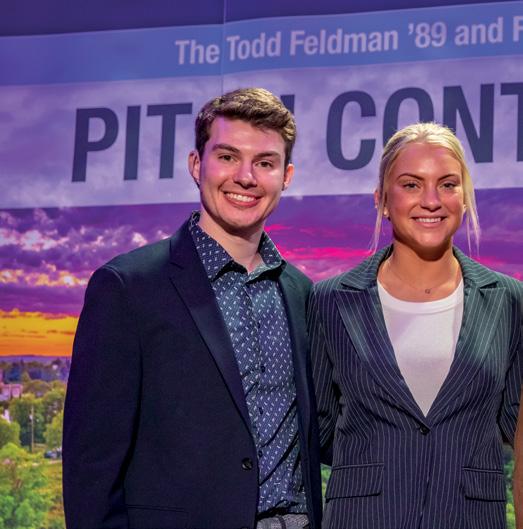
 BY NATALIA ST. LAWRENCE ’16
BY NATALIA ST. LAWRENCE ’16
The winner of this year’s entrepreneurial leadership competition — and a $10,000 grant to make his idea a reality — is Connor Quinn ’23, the creator of Water Watts. Water Watts uses a series of turbines placed inside water pipes in buildings to deliver renewable energy.
“This solution to our energy crisis is hiding right beneath our feet,” Quinn said during his pitch. “Currently, each American citizen uses an average of 82 gallons of water per day. And this flow of water provides an untapped source of energy.”
The Pitch included a special holographic experience, made possible by Todd Feldman ’89 and Proto, the original, patented, selfcontained interactive hologram device. The technology allows viewers to see, hear and interact with one another from anywhere in the world. While in Los Angeles physically, Feldman and the Inventor and CEO of Proto David Nussbaum were beamed onto the HWS Pitch stage for a Q&A about entrepreneurship. Howie Mandel, the host of America’s Got Talent, also made a special appearance.
This year’s judges included: Charlie Brind ’84, P’22, president of Westwood Benefits, Inc.; Deb Hauser ’83, P’22, P’24, residential real estate executive; Jason Magna ’95, P’27, founder and president of Riverside Partners; and Rafe Mattingly ’08, senior solutions consultant at TiER1 Performance and founder of Class IV Coffee Company. After every pitch presentation, the judges had the opportunity to vet the business plans. Hauser, during her questioning, said to Quinn, “This is a big idea, Connor. And we like big ideas.”
“This solution to our energy crisis is hiding right beneath our feet. Currently, each American citizen uses an average of 82 gallons of water per day. And this flow of water provides an untapped source of energy.”
—CONNOR QUINN ‘23
Sandeep Tissaaratchy ’26 and Lamia Nur Rahman ’26 won first place at the Novice Nationals debate tournament held at the University of Rochester, beating teams from Princeton and Stanford Universities among others. The pair of HWS debaters also each ranked among the tournament’s top individual speakers: Rahman placed 9th in the novice division and 4th in English as a Second Language (ESL), while Tissaaratchy ranked 5th in the ESL division. Later in the semester, Rahman and Tissaaratchy won the Colgate Open. Tymofi Trakchov ’26 and Grace Wilson ’26 also found success at the tournament as finalists in the Rookie division.


English major and German Area Studies minor Ian Albreski ’23 is the recipient of a 2023 U.S. Student Fulbright Award to Germany where he will serve as an English Teaching Assistant. Albreski, who studied abroad at the University of Tubingen, has twice been awarded the Julius C. Blocker German Area Studies Fellowship in support of his research and scholarship on German culture.
This spring, Hrithik Biswas ’23, Emma Brachfeld ’23, Sam Calderon ’23, Kate Equinozzi ’23 and Johanna Golden ’23 were invited to serve as Peace Corps volunteers for two-year placements in North Africa, Eastern Europe, and Central and South America. For the five graduates, the international service program is an opportunity to engage their academic interests in international development and policy as well as their commitment to public service.

“Once again, Hobart and William Smith students demonstrate why our campus is known for a commitment to community service and global engagement,” says President Mark D. Gearan, who served as the 14th director of the Peace Corps from 1995 to 1999. “I have no doubt that Hrithik, Emma, Sam, Kate and Johanna will fulfill their Peace Corps assignments with distinction, making a tremendous impact on the communities they serve and in the process experience invaluable insights about the world and themselves.”
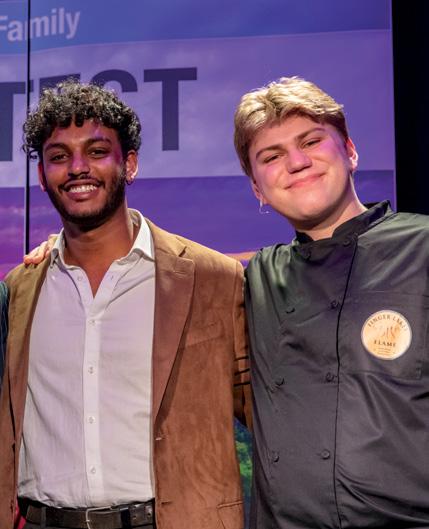
Anchored by a $5 million lead gift from Kevin Stein ’88, support from alums provides the financial foundation for a state-of-the-art facility that will be the hub of scientific education at Hobart and William Smith.
BY ANDREW WICKENDEN ’09Studying science and math is like “learning a language,” says Kevin Stein ’88, a language that’s “practical, pragmatic and teaches wonderful problem-solving skills.” To expose more students “to a topnotch science education in a liberal arts environment” and encourage “well-rounded practitioners of this wonderful language,” Stein and his family have committed to a leadership gift of $5 million that will anchor the development of a new science facility at Hobart and William Smith.
With additional gifts of $500,000 from Dr. Arnold Cohen ’71, P’05 and his wife Dr. Colleen R. Carey P’05; $500,000 from Trustee Dr. Richard Wasserman ’70 and his wife Tina Wasserman; and $100,000 from Betty Good ’75, the Colleges are readying for the next stages of the integrated science center project, which will centralize and further encourage the collaborative, interdisciplinary teaching, learning and research already happening on campus.
“Our faculty and students will benefit tremendously from the new science center and the support of our alums, who know firsthand the life-changing teaching, mentorship and research opportunities that take place at the Colleges,” says President Mark D. Gearan. “We are incredibly grateful for the leadership of our accomplished alums and their families, whose support ignites our plans moving forward and will propel the success of our students and faculty.”
STEM fields were always a passion for Stein, now President, Chief Executive Officer and Director of TransDigm Group Inc., a leading global producer, designer and supplier of highly engineered aerospace components, systems and subsystems to commercial aerospace and military programs around the world. It was at HWS, though, where Stein found “the mentoring and close relationships with faculty members, advisors, deans and presidents that was instrumental in my career,” he says. Teachers like Professor of Chemistry Romana Lashewycz-Rubycz and Professor Emeritus of Chemistry Kenneth Carle P’82, P’84, P’90 inspired

him to “chase the challenges” and “keep learning new things.… It’s pretty awesome that I can give back to the institution that really molded me and gave me a sense of purpose and commitment to community.”
Dr. Cohen, a retired gastroenterologist, says: “Over the years, I’ve become convinced that the best preparation for becoming a physician was at a liberal arts college with a strong science program.”
A Professor of Medicine at the Washington State University College of Medicine and an Associate Clinical Professor Emeritus at the University of Washington School of Medicine, Dr. Cohen credits Hobart and William Smith with his own intellectual growth and preparation for Harvard Medical School and life as a physician. As he puts it, “HWS changed the way my mind worked.”
He hopes the new science center enriches STEM education for science majors and non-majors alike, and attracts top faculty and prospective students.
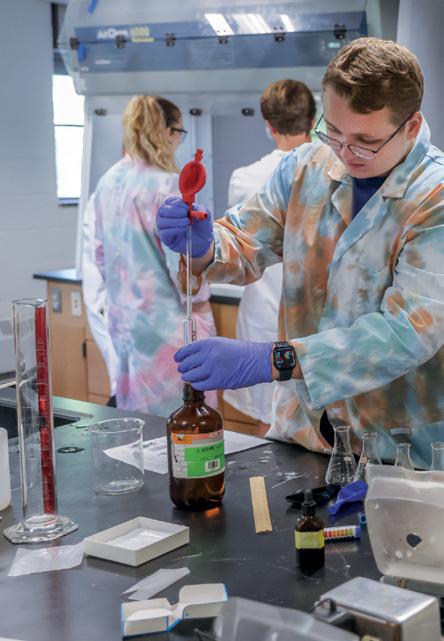
Dr. Wasserman, who serves as Medical Director of Pediatric Allergy and Immunology at Medical City Children’s Hospital, says: “The major strength of my HWS education was the liberal arts context within which I learned. My perspective of science as one of the liberal arts has shaped my life’s work as a physician and clinical investigator.… My wife, Tina, and I have supported the new science center because we believe our science faculty and students are poised to surpass their recent scientific research and educational achievements and deserve a modern, state-of-the-art facility to achieve those goals. We hope that you will join us.”

Good, a retired Vice President of the Bank of New York, says that “a new, up-to-date facility is key to attract students who want to come to HWS, particularly women.” Although she was an economics major, Good wants to support young women who are “bridging the gender gap in STEM fields. More and more women are majoring in STEM, so the new science center is being planned at the right time.”

▼
In addition to the $5 million lead gift from Kevin Stein ’88, the Colleges’ new science center project has seen early support from Dr. Arnold Cohen ’71, P’05, Betty Good ’75 and Trustee Dr. Richard Wasserman ’70.
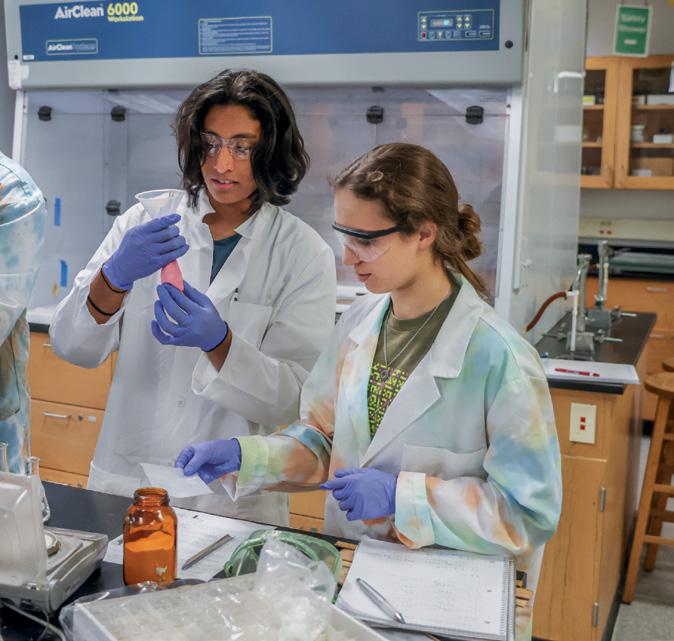
To learn more about the science center project, contact Vice President for Advancement Bob O’Connor P’22, P’23 at oconnor@hws.edu or (315) 781-3535.

“It’s pretty awesome that I can give back to the institution that really molded me and gave me a sense of purpose and commitment to community.”
—KEVIN STEIN’88 ▲ Thomas McCue ’26, Javier Pacheco ’26 and Rachel Faust ’26 work in the Accelerated General Chemistry lab of Technician David Slade. Plans are currently underway for a new science facility on campus.
This spring, the HWS community gathered for a ribbon-cutting to celebrate the opening of the newly renovated and expanded Adams Intercultural Center.
BY NATALIA ST. LAWRENCE ’16In April, generations of alums returned to campus, joining students, faculty, staff and Geneva neighbors to celebrate and tour the newly renovated and expanded Adams Intercultural Center (AIC), named in honor of the Rev. Alger L. Adams ’32, D.D. ’83, Hobart College’s first Black graduate.

Thanks to a leadership gift from Board Chair Craig R. Stine ’81, P’17 and Kathy Hay Stine P’17, the AIC includes newly renovated social spaces, offices, a computer lab, and a multipurpose room for students, faculty, staff and community members to gather in dialogue.
During the dedication ceremony, Stine reflected on the goals he identified when he began his term as board chair. “At the top of the list,” he said, “is the creation of a campus culture of belonging. It is my belief that the better future we seek will be created in spaces like this one.”
The AIC expansion includes the addition of the Stine Multipurpose Room, which provides space for large groups to gather for forums and dialogues. With gratitude for their philanthropy, the AIC living room has been named in honor of Gregory J. Vincent ’83, President of Talladega College and past president of HWS,
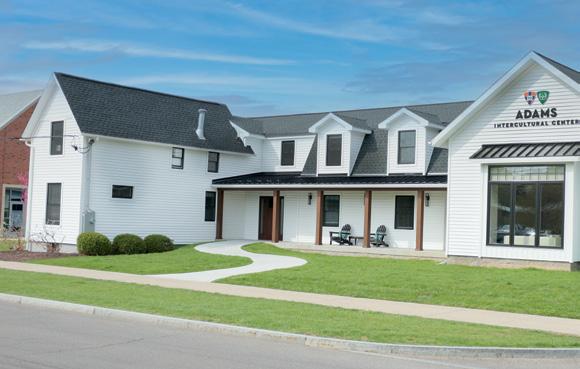
and the office suite in honor of Rafael Rodriguez ’07, Associate Vice President and Dean of Students at New York University.
During the ceremony, Alger Adams’ daughter Patricia L. Adams L.H.D. ’23 reflected on her father’s accomplished life, including his skill as a painter. She shared how important it was to her father, and to herself, to find a place of lasting display for his artwork. To that end, Patricia announced that several of his pieces would be housed in the AIC in perpetuity, alongside works by Faith
Bey ’21, Rosemary Colon-Martinez ’21 and Jenny Wu ’12. Patricia also donated her father’s Phi Beta Kappa pin, which she remembers him proudly wearing and displaying throughout his life.
Patricia, who was awarded an honorary degree during this year’s Commencement (p. 49), imagined what her father might say during the historic dedication of the AIC: “Today’s dedication is indeed an honor. It is also a beacon. This dedication is about the future, looking forward, and building on existing good work.”
▲ The new Adams Intercultural Center is “the fireplace of our campus around which we all gather,” said President Mark D. Gearan at the ribbon-cutting ceremony.


▲ Associate Director of HEOP/AOP Edith Wormley; Vice President of Diversity, Equity and Inclusion Bill Woodson; former President Gregory J. Vincent ’83; President Mark D. Gearan; Patricia Adams L.H.D. ’23; Board Chair Craig R. Stine ’81, P’17; Gabriela Martinez ’22, MSM ’23; Chaplain and Dean for Spiritual Engagement Nita Johnson Byrd; Director of Intercultural Affairs Alejandra Molina; Rafael Rodriguez ’07; and Director of Opportunity Programs Renée Grant at the AIC opening.

As part of the grand opening of the Adams Intercultural Center, HWS hosted the seventh Multicultural Networking and Career Conference, an opportunity for students to meet, learn from and network with alums of color at various stages in their careers. The conference included a retrospective, “HWS Through the Years,” moderated by President of Talladega College Gregory J. Vincent ’83, as well as networking opportunities and panel discussions with alums who have launched careers in entrepreneurship, nonprofit leadership and education. The conference was made possible through the support of the Afro-Latino Alumni and Alumnae Association in coordination with offices on campus.
This Place II, part of a series of multimedia landscapes created by Professor of Art and Architecture Nick Ruth, has been acquired by the Metropolitan Museum of Art. The 2022 screenprint and colored pencil work will be housed in the museum’s permanent collection.
“For me this series is about world-building, and in this case that involved repurposing imagery from Renaissance engravings and then amplifying the new space with intense color,” says Ruth. “That is apparently part of what helped them get interested. Needless to say, I am thrilled.” >>

In the Provenzano Student Art Gallery, William Argueta Pinedo ’24 mirrors his pose in a photo by Syed Muhammad Jafri ’24, which in turn mirrors Gustave Courbet’s The Desperate Man (1844-45). In “Savage Sensuality,” a spring exhibition at the Provenzano Gallery, Jafri recreated canonical works of art to examine the politics of identity and representation. With support from Dominic Provenzano ’72, P’04, the gallery opened in 2022 on the ground floor of Scandling Campus Center and regularly showcases student art exhibitions. Jafri’s work was curated by Adriana Croce ’25 as part of her art history capstone project.
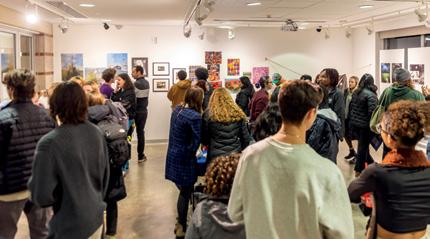


A Guide for Advocates and Activists on Staying Healthy, Inspired, and Driven Jamie Bodenlos, Professor of Psychological Science, and Dara Friedman-Weller

Gender at the Theatre in Early Twentieth-Century Argentina and Mexico
May Summer Farnsworth, Professor of Spanish and Hispanic Studies
A Social Epistemology for the Internet Karen Frost-Arnold, Associate Professor of Philosophy

Competition as the New Normal of China–US Relations
Jinghao Zhou, Associate Professor of Asian Studies

In 24 hours, alums, families and fans gave more than $1 million in support of HWS student-athletes, coaches and trainers.
The 2023 Hobart and William Smith Athletics Day of Donors shattered the record for the most dollars raised in a single day, with just over $1 million raised for Statesmen and Herons teams.
“On behalf of everyone in Hobart and William Smith Athletics, thank you for the incredible generosity,” says Brian Miller, associate vice president and director of athletics and recreation. “The loyal support of the HWS community for our Herons and Statesmen will allow us to make meaningful enhancements to the student-athlete experience.”
The fundraising total includes a challenge gift of $25,000 from Cynthia L. Caird L.H.D. ’12 which provided bonus cash for teams and programs that raised the most; that had the sharpest increases in donor participation; and that produced the most creative fundraising videos.
After this year’s Athletics Day of Donors, Vice President for Advancement Bob O’Connor P’22, P’23 noted that “it’s hard to say who is more competitive, the current Statesmen and Herons or our passionate fan base. We are deeply grateful to Cindy Caird, our coaching staffs, Brian, Associate Athletic Director Liz Dennison, and our SAA and Heron Society boards for their steadfast support.”
BY THE NUMBERS$1,030,854 DONATED
3,639 DONORS
167% OF THE $615,000 FUNDRAISING GOAL
In April, 10 outstanding Hobart athletes were honored in a campus ceremony and officially inducted into the College’s Hall of Fame. The Class of 2023 includes Hobart Hockey Head Coach Mark Taylor, Shawn Mizro ’07 (football), Rob Pisanelli ’00 (basketball), Ali Marpet ’15 (football), Kevin Martin ’81 (lacrosse), Tyre Coleman ’15 (football), Keith Longo ’09 (hockey), Jeffrey Thon ’77 (football and baseball), Harold Draffen ’75 (lacrosse) and Scott Petosa ’80 (lacrosse). The Class of 2023 raises the roll of Hobart Hall of Famers to 135 legendary Statesmen.

During a 21-game win streak on their way to the national semifinals, William Smith lacrosse tallied their seventh straight Liberty League title. The Herons’ 340 goals broke the previous season’s record by 20 goals. The third-ranked William Smith team was defeated only once during the season, in the NCAA semifinal game against Gettysburg.

In their first season as a varsity sport, the William Smith alpine skiing team finished in third place at the U.S. Collegiate Ski and Snowboard Association’s National Championships in Mammoth Lakes, Calif. Six members of the team — Caraline Gray ’23, Bridget Weier ’23, Ashley Byron ’24, Emilie Waters ’24, Marjorie Plants ’25 and Katherine Broderick ’26 — were also recognized by the USCSA as Scholar All-Americans for their performances on the mountain and in the classroom.
 ◀ William Smith skiers celebrate on the slopes during the 2023 USCSA National Championships in California.
The Herons celebrate their seventh consecutive Liberty League championship.
◀ William Smith skiers celebrate on the slopes during the 2023 USCSA National Championships in California.
The Herons celebrate their seventh consecutive Liberty League championship.
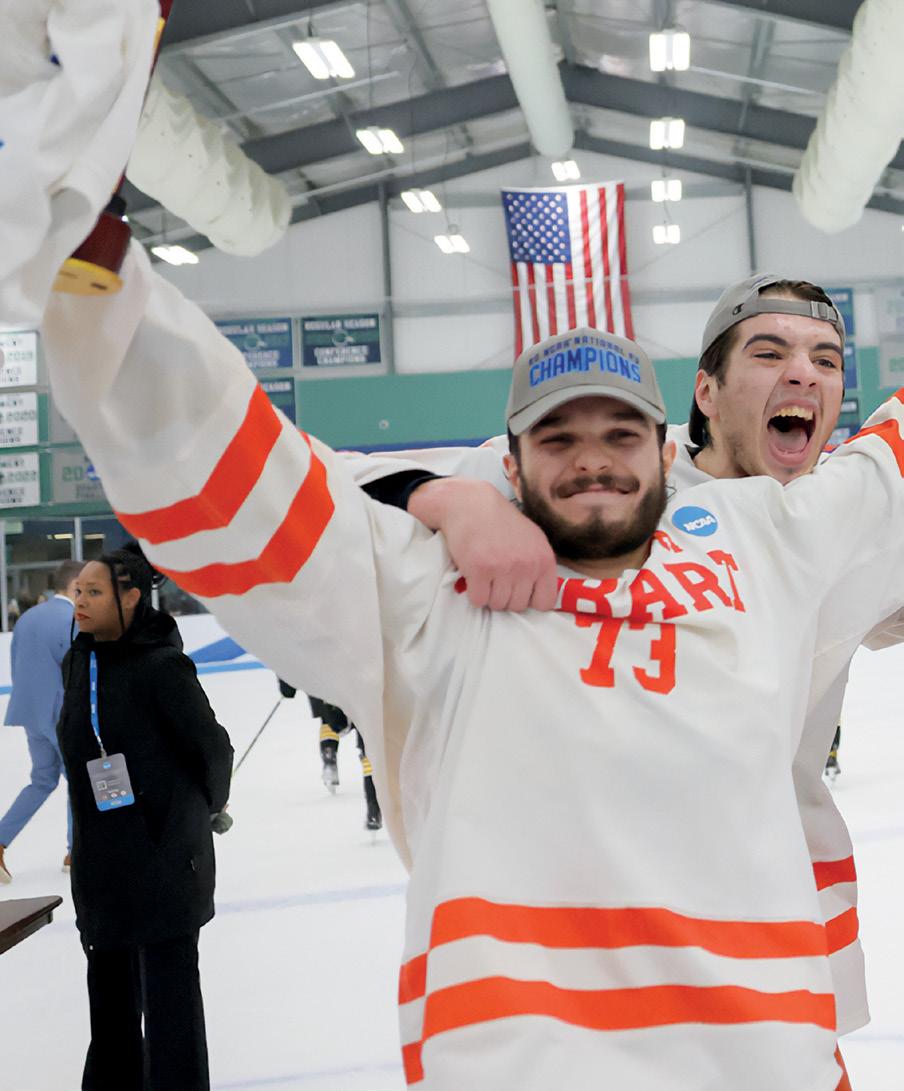

A hockey season is a journey in every sense and when the Statesmen embarked last October on the path toward their first national title, the players had established their waypoints. The coordinates? 1-8-4-1.
“During the season, it was a combo to a door the team had to use every day. I knew the guys would have to punch that number in every single day, all year long,” says Head Coach Mark Taylor.
The first “one” referenced the Statemen’s goal of being the top team in the New England Hockey Conference; the “eight” reflected their vision of reaching an eighth consecutive NCAA Tournament; “four” represented advancing through the national tournament to the Frozen Four; and the final “one” was the big one: Hobart, the last team standing, winning their first ever national championship.
The moment came — after 149 days, 31 games and nearly 6,000 miles — when Wil Crane ’24 fired home a one-timer with 5:05 remaining in overtime, lifting Hobart over Adrian 3-2 and clinching the NCAA Division III Men’s Ice Hockey National Championship. Along the way, the Statesmen compiled a 29-2-0 overall record, including a perfect 19-0-0 at The Geneva Recreation Center (The Cooler) and a 20-0-0 record wearing their home white jerseys. The 29 wins are the most in a single season in program history and are tied for the sixth most in NCAA Division III history. During the regular season, the Statesmen were 16-2-0, capturing their second consecutive NEHC title. Hobart’s .935 winning percentage is seventh on the NCAA list. The team opened the year winning its first 14 games of the season, setting a new program record, and ended on a 12-game winning streak; both streaks snapped the previous program record of 10 from 2014-15.

Hobart’s historic season got off to a storybook start. Led by longtime Head Coach Mark Taylor, the Statesmen defeated Oswego State 5-2 in their home opener at The Cooler on Oct. 28, and from there, they were off to the races, winning the next four games at home, including a pair of one-goal victories over Southern Maine and Cortland. The Statesmen hit the road for the first time in early November, posting three consecutive shutouts with wins over Cortland (5-0), Johnson and Wales (5-0) and UMass Boston (3-0). Following the win over the Red Dragons, Hobart moved up to No. 1 in the USCHO. com poll for the first time in program history, starting a 10-week stretch with the Statesmen ranked first in the country. After fall break, the team played the final five games of 2022 at The Cooler. During that stretch, Hobart won three consecutive 2-1 games against Trinity, Colby and Salve Regina.
January began with a four-game road trip, Hobart’s longest of the season. The Statesmen extended their win streak to 14 games with a 3-0 win over New England College. The next day, Norwich handed Hobart its first loss of the season; the Cadets scored twice in the second period and held on for the 2-1 victory. The Statesmen bounced back with wins over Southern Maine and Babson to close out the road trip.
Hobart returned to New York for a weekend series with travel partner Elmira. Each team won the game on their home ice, but that loss would be Hobart’s last of the season. On Feb. 10, the Statesmen faced Norwich again, this time clinching the regular season title with a 3-2 win. Hobart finished the season with a historic 23-2-0 record; the previous record for wins in a season, 21, had been tied five times but never broken — until now.
As the regular season champions, Hobart earned the No. 1 seed in the New England Hockey Conference tournament, where the team met eighth-seeded Castleton University in the first round. The Spartans gave Hobart
everything they could handle for 40 minutes and took a 3-2 lead going into the second intermission, but in the third period, the Statesmen erupted for five goals and emerged with a 7-3 victory. Six Statesmen had a multipoint game that night, including Tanner Daniels ’26 and Luke Aquaro ’25, who scored two goals apiece.
The NEHC semifinal game pit Hobart against a fifth-ranked Skidmore team, coming off an upset win over Elmira. The Statesmen emerged victorious 1-0 in a goaltending battle against the Thoroughbreds. Damon Beaver ’26 stopped all 26 shots he faced as he earned his seventh shutout of the season.
Captain Zach Tyson ’22, MSM ’23 scored Hobart’s goal at the 3:19 mark of the second period. The win over Skidmore ensured that Hobart would host the NEHC title game at The Cooler for the first time.

The March 4 contest against 13th-ranked Babson saw Hobart hoist the Mariano Cup, the team’s second NEHC tournament title. The 5-1 victory was led by Aquaro, who scored twice, along with Tyson, Daniels and Jonah Alexander ’24, who put up Hobart’s other goals, while Beaver continued his strong play with 14 saves.
Following the championship game, Tyson was named the tournament’s Most Valuable Player. He was joined on the all-tournament team by Aquaro, Beaver, Daniels and Matthieu Wuth ’24.
Two days after winning the NEHC championship, Hobart was given a firstround bye to the NCAA Division III Men’s Ice Hockey Championship. The Statesmen have been selected to eight straight NCAA tournaments, the longest active streak in the nation. With the first-round bye, Hobart needed only one win to achieve its third goal, advancing to the national semifinals.

Hobart met seventh-ranked Curry College in the quarterfinals. After a goalless first period, the Colonels scored at the 8:56 mark of the second period. The Statesmen bounced back eight minutes later, scoring three times in 35 seconds for a 3-1 lead at the end of two
periods. The goals — courtesy of Brenden Howell ’23, Cooper Swift ’25 and Kahlil Fontana ’26 — were the fastest trio in the Mark Taylor era. Tanner Daniels ’26 and Ignat Belov ’26 added goals in the third period as Hobart secured its fourth trip to the national semifinals with a 5-1 win.
One last road trip, one last milestone. The national semifinals brought the Statesmen 382 miles east to Endicott College’s Raymond J. Bourque Arena, where they competed against their fourth-ranked hosts, Endicott. For the second straight game, Hobart was down 1-0 midway through the second period. And for the second straight game Howell scored the equalizer. Beaver stopped all 25 remaining shots on goal, and in the third period, Aquaro and Austin Mourar ’24 notched goals to send the Statesmen to the national championship game for the first time in program history. Two days later, Hobart faced the thirdranked defending champions, the Adrian College Bulldogs, in the title game. The Statesmen jumped out to a 2-0 lead in the first period thanks to goals from Aquaro and Shane Shell ’25. The Bulldogs rallied to tie the game 2-2 with
▲ Luke Aquaro ’25 carries the puck into the offensive zone during the championship game. Aquaro finished the season leading the Statesmen with 21 goals and 39 points. ▼ Goaltender Damon Beaver ’26 posted a program-record seven shutouts this season. PHOTOS BY KEVIN COLTON L.H.D. ’23just over five minutes remaining in regulation. After a frantic 14 minutes in overtime, Wil Crane ’24 scored the game-winning goal.
“We got the puck low and coach was telling us to work down low all night,” Crane said of the game-winning goal. “Brenden Howell got a shot off in the slot and the puck came to me and I was fortunate to put home a rebound and kind of blacked out after that. Couldn’t have written a better script.”
Tyson, who continued to captain the team as a graduate student, said Hobart’s 1-8-4-1 season-long vision kept him motivated. “I came back because I wanted to, first off, win an NEHC Championship — we checked that off, both regular season and playoffs. I wanted
another crack at the [NCAA] tournament, and we crossed that off the list,” he said. “It feels great to get it done.”
Beaver, who made a season-high 37 saves as he earned his 18th win of the season, was named the tournament’s most outstanding player and earned a spot on the AllTournament team, alongside Mourar, Aquaro and Crane.
“It starts with the defensemen, coach and the players, and having everyone on board,” Beaver said of his performance. “It gives me so much confidence that they are in front of me. I just try to stay humble in victory and defeat. But my confidence all starts with the guys in front of me.”
As Coach Taylor told the Boston Globe after the championship victory, the team’s heart, determination and unity was palpable on the ice. “I thought there was a lot of character out there,” he said. “The experts will say it was an offensive game, a defensive game, but to me, it was a character game.”
The awards piled up for the Statesmen in the days leading up to and following the national championship. Head Coach Mark Taylor, who also coached Team USA at the Lake Placid 2023 FISU World University Games, was recognized with the 2023 Edward Jeremiah Award as the American Hockey Coaches Association Division III Men’s Coach of the Year. He was also named Coach of the Year by the New England Hockey Conference and USCHO.com.
Forward Luke Aquaro ’25 was the runnerup for the Sid Watson Award as the national player of the year. In addition, he was named a 2022-23 CCM/American Hockey Coaches Association East first team All-American. The NEHC Player of the Year also earned a spot on the All-USCHO.com team. Forward Jonah Alexander ’24 was named to the All-America East second team.
Along with being named the MVP of the NCAA tournament, goaltender Damon Beaver ’26 was named the USCHO.com Rookie of the Year and the NEHC Rookie of the Year.

“ I thought there was a lot of character out there. The experts will say it was an offensive game, a defensive game, but to me, it was a character game.”
—HEAD COACH MARK TAYLOR, BOSTON GLOBE
Hobart finished the year ranked 10th in the nation in scoring offense, averaging 3.97 goals per game. The Statesmen scored 123 goals and had 203 assists for 326 points. Hobart was fifth in the nation in points and seventh in assists. The Statesmen’s .935 winning percentage was best in the nation. Aquaro led the team with 21 goals and 39 points. He was the first Statesman since Nick DeCroo ’09 to score 20 goals in a season. Alexander and Shell had a team best 20 assists. Twenty-four of the 27 players who saw action in a game this season recorded at least one point.
The Statesmen finished the year first in the nation in scoring defense, tallying the secondbest mark in NCAA history. Hobart allowed a mere 37 goals this season, the fewest in program history. The Statesmen goalies combined for a program record .947 save percentage and nine shutouts, putting the Statesmen at fifth in DIII history for most
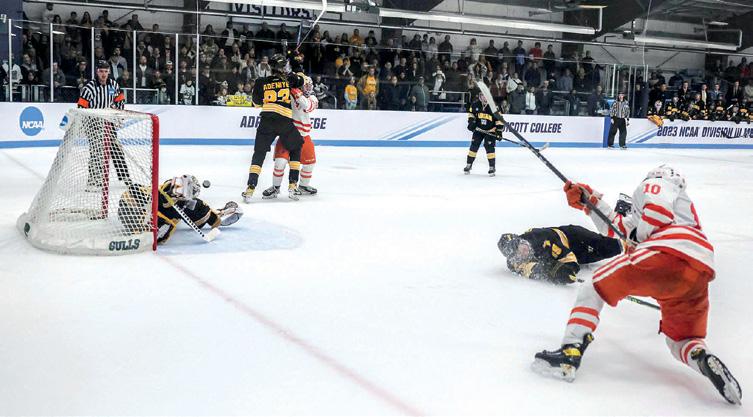

shutouts in a season. Beaver’s outstanding performance between the pipes yielded a program-record seven shutouts (putting the first-year third on Hobart’s career list). He was also the first goalie in program history to record three consecutive shutouts, with wins over Cortland (5-0), UMass Boston (3-0) and Skidmore (4-0) in November. Beaver’s season is also among the best in Division III history, ranking third in goals against average and fourth in both save percentage and shutouts. All three marks were program records.
▼
Flanked by President Mark D.
Head Coach Mark Taylor; Assistant Coach Tom Fiorentino ’14; Associate Athletic Director for Sports Performance and Strategic Initiatives and the John J. Hogan ’88 Strength and Conditioning Head Coach Chris Grey; and Director of Athletics Brian Miller, the 2023 NCAA Division III Men’s Ice Hockey Champions celebrate with some of their biggest supporters.
▲ Wil Crane ’24 fires home the game-winning, overtime goal to lift Hobart to its first national championship in program history.Hobart Hockey Head Coach Mark Taylor reflects on a championship season and the mindset that propelled the team through the final game.
BY PAIGE COOKEAt the helm of Hobart Hockey for 23 years, Mark Taylor has led the program to 20 consecutive winning seasons, building toward the 2023 national title. He is the most successful coach in the team’s history, compiling a record of 378-174-54 and guiding the Statesmen to 12 NCAA tournament bids. In 2023, he was named the Coach of the Year by the American Hockey Coaches Association and the New England Hockey Conference, and was inducted into the Hobart Hall of Fame. Earlier this year, Taylor guided the United States to a silver medal at the FISU World University Games in Lake Placid.
An active member of the hockey community, Taylor has coached in the USA Hockey Development program and the Geneva youth hockey program. Prior to joining the Colleges, he served five seasons as the top assistant coach at the University of Massachusetts at Lowell and five seasons in the same role at Cornell University.

A 1985 graduate of Elmira College, Taylor was the Soaring Eagles’ MVP and an All-ECAC selection as a senior. He transferred to Elmira after a pair of National Junior College Athletic Association Championships at SUNY Canton, earning All-American defenseman honors for the Northmen. Following his graduation from Elmira, Taylor played two seasons for Ange in the Swedish Ice Hockey Federation.
What were you thinking when the championship game went into overtime? My conversation with the guys going into overtime was very confident and very succinct — just keep doing what we are doing. Assistant Coach Tom Fiorentino ’14 and I both thought it gave the guys a breath of fresh air to go out and stay the course. We had done that all year. If you’re comparing it to the Muhammad Ali-Joe Frazier fight, I’m not Ali. I’m Frazier. I’ve got to stay at it a little longer slugging. That’s who I’ve been throughout my career, and that’s what we’ve been as a program — staying at it, staying the course, doing what we do the best we can.
What does it mean to you to win the national title? It means a lot to me because I know it means so much to so many people. It’s a combination of years of hard work and perseverance by the players and coaches I have worked with and those before me who started the program. This title is for everyone who played through tough times and good times but didn’t get it. For me, it is the satisfaction that comes with all of us getting there.
What made this year special? I’ve coached quite a few special teams in my time. We have been lucky to have some really great teams with AllAmericans and Hall of Famers on the roster. There were also things that I’ve learned as a coach going into my fourth national semifinals versus the first. It was all building blocks to get us there — and this year, everything aligned for us. The saying goes: “You have to be talented, you have to be lucky and you have to have some special stuff — some mojo — that little bit extra.” This group had some special mojo.
Tell us about “building a boat.” This year we wanted to build something together, as a team, so the season’s theme was building a boat. Each game, we envisioned building a different part: collecting the wood, making the sail. The guys envision the pieces all season and it helps us come together as a group. In fact, just before NCAAs we purchased some wood and tools, thanks to donations of our supporters and alums, and the players carved their own paddles. We named our sail Momentum early in the year and that served us well; we named the boat Tenacity before the national semifinals; we knew if we were going to win, we would have to play tenacious, and I thought we did. That mindset was huge going into overtime. We were unbridled and tenacious in our play and that was something that gave us an edge.
What major challenges did the team face this year and how did you overcome them? I think the major challenge — which didn’t trip us up — was when Luke [Aquaro ’25], Swiftie [Cooper Swift ’25] and I went to the World University games. It didn’t derail the team. Other guys got opportunities. There were a lot of nuances and distractions during that time, but I think we were a strong enough team and a selfless group that it went the other way. It strengthened us as a group.
The team was also very aware of what is going on in Artem’s life. Artem Buzoverya ’24 is from Kharkiv, Ukraine and his dad is still living in Ukraine, where he is on active duty. It was something that the guys carried with them this season.
In the Boston Globe, you described the national championship game as a “character game.” When you get to those final games in the tournament, everyone is talented. You had the best offensive team in the country in Adrian and the best defensive team in us. To me, you need to have the right type of character. Emotions are high, and if you don’t stay locked in and focused, that can hurt you. You have to stay strong as an individual and as a team. With my teams, I’ve always used the phrase “conduct by character.” Whatever you do, whether playing a championship game or life itself, if you conduct yourself with good character, you have a really good chance of doing well.
Tell us about the HWS community’s support for the team and the name of the national championship trophy. We named it Perseverance in homage to the alums and to fans, to former assistant coaches, to professors across campus and to everybody that supported us. There was so much heart and loyalty that goes way, way beyond this team. This whole team feels that and is excited about that. It was their special moment on the ice, but it wouldn’t have been nearly as special if it weren’t for all of those people.
The support does not go unnoticed. From guys I coached my first year, guys I coached last year and all the years in between — they were all around the rink. Our fans dominated the Endicott arena. I saw people from Geneva, families with kids, guys who played before I got here when the program was first built. It means so much to see all those people there and so excited for the moment. I’ve had so many great teams with great journeys. I wish some of those teams could have had it, but I think the theme for everyone was, “We got it.” That’s the beauty of it.
Assistant Coach Tom Fiorentino ’14 shares his insights on the remarkable season. Since joining Hobart’s hockey staff ahead of the 2018-19 season, Assistant Coach Tom Fiorentino ’14 has helped steer the Statesmen to four berths in the NCAA tournament, including the 2023 national championship. He has mentored two All-Americans, 16 All-NEHC selections and two USCHO.com All-Rookie team picks. A four-year member of the Hobart hockey team, Fiorentino served as a captain in his senior season. His play landed him a spot on the ECAC West All-Academic Team three years in a row and earned him the Holden Award for sportsmanship, character and leadership. After graduation, Fiorentino played two seasons of professional hockey with Les Phenix de Reims in France, where he led the team in goals and ranked in the top 20 in the league in points. He then spent two seasons in the Southern Professional Hockey League, playing for the Evansville Thunderbolts, the Pensacola Ice Flyers and the Fayetteville Marksmen.

What are the ingredients that made this year’s team so successful? At the beginning of the year, the guys set some goals they wanted to achieve as a group — they did that without me or Coach Taylor, so they were able to take a real ownership of it. The culture of the group is extremely strong and balanced, and that allowed them to stay focused on what they wanted to achieve, no matter what was thrown our way.
What was it like, both as a former player and now as a coach, to see Hobart hoist the trophy? Once you hang up the skates and are done playing, you’re always following along and hoping for continued and elevated success, so as an alum of the program, it’s an unbelievable feeling. The team feels that pride and energy from the alums, year in and year out, and it no doubt contributed to our success. And to be able to come back as a coach and have a small part in it all is awesome.
Can you reflect on some of the ways the program has evolved between your time as a student-athlete and now? The level of hockey has grown each year for sure, but every year we always have a great group of young men. That culture was established back in 2000 when Coach Taylor arrived and is a point of continuity that will never change here. Each year, the guys are continually trying to elevate the program and raise the bar. It’s a hungriness to leave the program in a better place than you found it (a Coach Taylor motto), so in a lot of ways, not much has changed. This year was the culmination of years and years of great Hobart Hockey players who wore the sweater.
When a check knocked Gagik Malakyan ’24 to the ice during the New England Hockey Conference Championship, teammate Artem Buzoverya ’24 sprang into action. He and Assistant Athletic Trainer Sara Moore crossed the ice to Malakyan, who had suffered a seasonending knee injury. Arm-inarm, Buzoverya helped his injured teammate off the ice and onto the bench, where Malakyan cheered Hobart on to victory over Babson College for the NEHC title.
“At a glance, this story is about a teammate helping a teammate. And we’re proud of the camaraderie on the team. But on our campus we can witness the broader significance and powerful symbolism of a Ukrainian national and a Russian in national skating arm-in-arm off the ice,” says President Mark D. Gearan.
Buzoverya is from Kharkiv, Ukraine, Malakyan from Moscow, Russia. In Geneva, they are teammates, classmates and housemates.
“Gags and I are in a different boat, but at the end of the day, we both have families that are struggling. Neither of us have been able to see our families in about two years,” Buzoverya says.
During a watershed year marked by escalating violence at home and the triumph of Hobart’s national championship, they both relate to feeling like they’re on an emotional rollercoaster.

“Every time you step on the ice, you kind of forget about your problems and enjoy the moment with the guys,” Malakyan says. “But then you get off the ice and you’re back in reality again, picturing all this stuff that is going on in the world and you can’t do anything about it.”
Close to the Russian border, Buzoverya’s hometown of
“At a glance, this story is about a teammate helping a teammate. And we’re proud of the camaraderie on the team. But on our campus we can witness the broader significance and powerful symbolism of a Ukrainian national and a Russian national skating arm-in-arm off the ice.”
—PRESIDENT GEARANKharkiv has been hit by Russian missiles; damage to buildings and infrastructure has caused blackouts in the city. Buzoverya stays connected to his father and friends through the app Telegram, but otherwise, waits for news updates with the rest of the world.
“My dad is still back home and so are all of my
buddies that I grew up with. We’re just waiting it out,” he says. “There’s nothing I can do but hope I get to see my family soon and see them safe.”
Wrestling with feelings of helplessness, Buzoverya and Malakyan threw themselves into the campaign for the national title. Along the way, they found steady support
from their teammates and the HWS community.
“This is a really challenging time,” says Malakyan. “I’m thankful for my teammates, coaches, friends and faculty who are doing what they can to help.”
“Being around these guys, that’s been a major help,” Buzoverya says. “There are a bunch of parents who after every game gave me a big hug. They feel for me, and I know they’re reaching out and trying to be that role model and offer that support. I wouldn’t be here without all the support I’ve received.”
The philanthropy of Trustee Scott J. ’81 and Lynne Nowadly Mason ’80, P’13 will create an endowed head coach position for Hobart hockey while also supporting hockey operations and annual giving.

Through the generosity of Trustee Scott J. ’81 and Lynne Nowadly Mason ’80, P’13, the Colleges have created an endowed head coach position, the Mason Family Hobart Head Hockey Coach. The Mason's gift was made in honor of Hobart athletics and Hobart hockey, and pays tribute to the leadership and success of Hobart Head Hockey Coach Mark Taylor.
The announcement of the gift was made during the celebration of the Hobart Hall of Fame when Taylor was one of 10 inductees in the Hobart Hall of Fame Class of 2023.
“Scott Mason has been singularly devoted to Hobart hockey,” said President Mark D. Gearan during the ceremony. “Tonight — on the heels of the program’s first national championship and when Coach Taylor is inducted into the Hobart Hall of Fame — is the perfect time to announce Scott and Lynne’s extraordinary commitment. I thank them both not just for their generosity but also for their absolute belief in the hockey program and its coach. It is so greatly appreciated.”
Residents of Gladwynne, Pa., the Masons are longtime supporters of the Colleges. Scott and Lynne both earned degrees in history. Scott was a member of the first three Hobart varsity hockey teams, earning the team’s most improved award in 1980. They have three children, Alyssa, Andrew ’13 and Matthew.
In addition to creating the endowed coach position, the Mason's gift will support general operations of Hobart hockey and the HWS Annual Fund, which supports everything from academics and study abroad to internships and leadership programs.
“I’m an extremely proud alum of Hobart hockey,” Scott Mason says. “Mark Taylor is a good friend, a mentor to many and a leader to this program, as he so capably demonstrated this season. Lynne and I are happy to help sustain his leadership and the success of the Statesmen.”
Scott has served on the HWS Board of Trustees for nearly seven years. He is co-chair of the Asset Management Committee and serves on the Advancement and Communications Committee and the Enrollment Management Committee.
Additionally, Scott is a member of the Statesmen Athletic Association Board of Directors.

“HWS is an awesome place, but not just because of what’s in the acreage of the campus, but also the people around this community,” Taylor says.
“You go to school or you go to work, but you find yourself a second home. Scott and Lynne championed our program long before I arrived at Hobart and have been steadfast in their support throughout my time here. I’m humbled and grateful for their support.”
Every year, a percentage of earnings from the Mason Family Hobart Head Hockey Coach endowment will be paid out to benefit the Statesmen Hockey program. Endowment income can be used annually for various important programmatic benefits, including head coach compensation and retention, operating budget enhancements and to meet needs that maintain the competitive success of the Statesmen.
We were a bunch of guys with equipment at the bottom of duffle bags. None of us had played much since high school. Our leaders — Tracy Johnson ’63, Si Anthony ’63 and Joe Mechem ’64, P’91 — were organized, but corralling juniors and seniors to practice on Odell’s Pond in the winter was cold work.
Charlie Boswell II ’50, GP’20, our coach, was an inspiration. Though often frozen behind the bench, he never lost faith in our potential.
All games were away and late at night. Our competition: Syracuse, Ithaca, RIT and others. I can remember the echo of the puck in the Syracuse War Memorial, when we could count our fans on one hand, and the privilege of playing on the Cornell rink with its fresh paint and great ice!
To say that we had uniforms would be to elevate our ragtag assortment of equipment, infused with the hockey smell that seems to follow skaters everywhere; we did have jerseys, though who decided that our colors were blue and yellow is anyone’s guess.
It did not matter that we lost or won — and we came close a couple of times. What really mattered was we did it. We played. With “Hobart” printed across our chests.
I am proud to have been part of that team. I am also proud that my son Scott ’84, P’20 captained the 1984 team 21 years later. And now we have a team that skated through the Frozen Four and into the championship game. They performed at the highest level throughout the year, and thanks to great coaching and athletic grit, carried our team’s humble beginnings to great heights.
1917 Hockey is first referenced in the Echo.
1932
Intramural teams compete.
“The Hockey Club in its infant year and not yet recognized as an official Hobart team showed a lot of spirit and desire to play” (Echo, 1948). Through the following decades, the passion of the players and fans overcame scarce finances, propelling the Colleges toward establishing a fullfledged varsity men’s hockey program.

With funding from the Board of Control, Hobart’s first official club team begins play under Coach Charles Boswell II ’50, GP’20. The squad grew to 20 members, ending the inaugural season with a 2-3 record — “quite an accomplishment,” reported the yearbook, “since practice could be held only when skating on Odell’s Pond was possible.”
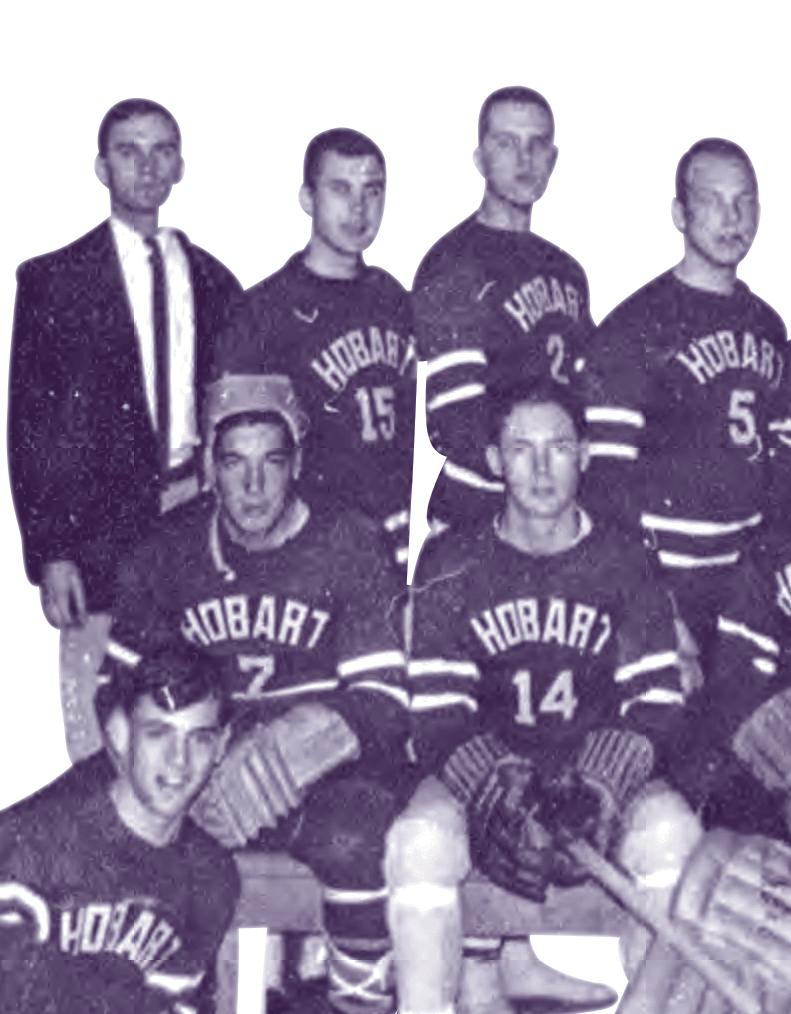
◀ Hobart’s first official club hockey team, ca. 1962-63. Row 1: John Cocroft ’66, Benjamin Hovey ’66; Row 2: Tom Dyett ’65, P’00, Tracy Johnson '63, John McQuilkin ’65, Si Anthony ’63, Joe Mechem ’64, P’91; Row 3: Hunter Corbin ’65, Ted Stock '64, Hank Holden ’63, P’84, P’89, GP’20, Frank Rosenberg ’66, Jim Anderton ’65, Bob Reynolds ’66, Jack Peterson ’64, Tom Finn ’65 and Coach Charlie Boswell II ’50, GP’20. Members of the team not pictured: Dixon Kunzelmann ’64, P’93, L.H.D. ’09, David Gibson ’65 and Everett Gardner '63.

Hobart wins their second consecutive NEHC regular season title, second NEHC tournament title and first ever NCAA DIII national title. Coach Mark Taylor, forward Luke Aquaro ’25 and defenseman Cooper Swift ’25 also lead the U.S. Men’s Hockey team to a silver medal at the Lake Placid 2023 FISU World University Games.
Gaining momentum: “For the first time ever, the [hockey] team has been granted some financial assistance by the Hobart Athletic Department” (The Herald, Dec. 7, 1973).
Bill Bergan ’86 is named team MVP. Twelve years later he became the first hockey player inducted into the Hobart Hall of Fame.
“In their first season of varsity competition the Statesmen skaters finished with a 15-16-1 slate.
Coach Bill Turner’s squad recorded victories over such established programs at RIT, Geneseo and Lehigh. After this promising rookie season the Hobart hockey program looks eagerly to the future”
(Echo and Pine, 1979).
Hobart Hockey makes first-ever ECAC tournament appearance.
1995
Keith Levinthal ’95 completes hockey career with school record 72 goals.*
1997
Eric Kisskalt ’99 sets school season assists record with 32.*
Travis Finkle ’00 completes career as all-time points leader at 155.*
2000
Mark Taylor is hired as head coach.
The Statesmen appear in their first of 12 NCAA tournaments. Hobart also won the ECAC tournament and regular season titles.
The Statesmen make their first trip to the NCAA Championship Semifinals with repeats in the 2008-09, 2018-19 and 2022-23 seasons.
2007
Keith Longo ’09 becomes Hobart’s first, first-team AllAmerican.
Geneva Recreation Complex is fully enclosed.
The team claims the first of two New England Hockey Conference Tournament Championships.

On campus and off, the HWS community rallied together to support the Statesmen throughout their historic season. Faculty and fans, students and staff, nearby neighbors and alums from across the country fueled the team to victory and were there to celebrate when the players and coaches returned to campus with the trophy.
Since 2006, the Faculty-Athletics Fellows Program has paired HWS athletics teams with faculty members to form lasting and meaningful relationships between students, professors and coaches. As Hobart Hockey’s Faculty Athletic Fellow, Professor of Environmental Studies John Halfman has been a fixture at games, including the NCAA Championship Tournament in Massachusetts, as well as a herald for Hobart’s achievements on the ice and a supportive advisor on campus.
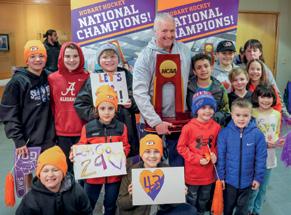

Do you have a hockey background yourself? I played goalie in junior high and quickly switched to basketball by high school, when I grew many inches and defensemen learned to shoot a slapshot.
Tell us about your philosophy as a Faculty-Athletics Fellow. FAF programming has multiple flavors. My involvement has always been low key. I watch home games and interact with hockey players who take my classes — they’re dedicated student-athletes, some of my best students over my many years at HWS. I also write emails to the community, mainly to celebrate student achievements and get HWS fans in the stands. This year was no different than any other. I get to watch great hockey and the players appreciate my presence, and especially my emails to get more folks in the stands during critical games. The community support during games, especially during Conference and NCAA tournament games, is very appreciated. It inspires better play.
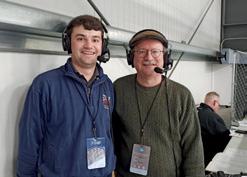
Can you describe the moment when the final overtime goal went in? The winning goal brought a huge sense of relief! I saw a similar reaction in Coach Taylor’s face as well. The team, players and coaches worked extremely hard all season long to get this win. I’m pleased to see it pay off.

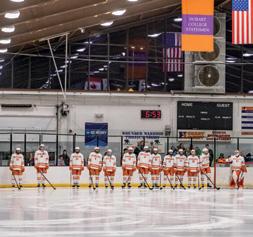 ◀ Hobart fans packed the Raymond J. Bourque Arena to watch Hobart take on Adrian.
▲ Providing exciting play-by-play commentary for the championship game in Massachusetts were Chris Guertler ’21, former WHWS-WEOS color commentator, and Ted Baker, longtime Finger Lakes region broadcaster.
◀ Hobart fans packed the Raymond J. Bourque Arena to watch Hobart take on Adrian.
▲ Providing exciting play-by-play commentary for the championship game in Massachusetts were Chris Guertler ’21, former WHWS-WEOS color commentator, and Ted Baker, longtime Finger Lakes region broadcaster.
The Statesmen have played at the Geneva Recreation Complex since it opened in 1978. Managed by Dave Sharman, the rink hosts HWS games and practices and is home to Geneva’s youth hockey programs.
For decades, the open-air rink exposed players and fans to the worst of the winter weather, hence its nickname: the Cooler. That changed in 2007 thanks to Geneva businessman and hockey enthusiast Bernie Lynch. Lynch spearheaded the project to enclose the rink and upgrade its facilities. With support from HWS and many state and local partners, the $1.2 million project saw insulated glass panels installed, a press box built and the Hobart Hockey team room expanded.

A consummate HWS supporter, Lynch employs Hobart players at his store, Lynch’s Furniture, during the summer. During the season, he can be found cheering the Statesmen from the northwest corner of the Cooler.
Joanna Penrod’s youngest sons Brad and Kylan were nine and seven when they started attending Hobart hockey youth clinics. It was 2015 and the family was going through a challenging time; Joanna hoped the sport would help them build connections — and it did.
After the youth team’s practices at the Cooler, Coach Taylor invited the boys to watch the Statesmen practice and soon the entire family joined the ranks of devoted HWS fans. You can often find them in the stands cheering on the Statesmen and Heron teams, but their love of Hobart hockey stands out. They’ve attended every Statesmen hockey home game — and some road games — for eight years, often bringing dozens and dozens of homemade donuts for the team.
“I just wanted to do something special for all of them,” says Joanna. “They were away from their families and working so hard at practice and at school.”
◀ Jimmy Steele ’89 trumpets Hobart’s strengths ahead of their NCAA tournament game against Curry at the Cooler. Steele brought the players custom “1841” sweatshirts, commemorating their season-long ambitions.
On campus and at the Cooler, on the road and on the ice, Statesmen hockey had support from HWS staff, who made sure the team was healthy, well-trained and well-equipped — and that their championship season didn’t go unnoticed.




Kevin Colton L.H.D. ’23 Chief Photographer

Adam Farid ’20 Videographer Coach Chris Grey Associate Athletic Director for Sports Performance and Strategic Initiatives and the John J. Hogan ’88 Strength and Conditioning Head Coach


Mackenzie Larsen ’12 Associate Director of Athletic Communications
The Penrods traveled to Massachusetts for the semifinal and championship games. “I just had a feeling they were going to win the whole thing,” says Joanna. “We booked our trip through Monday. There was a part of me that just knew after watching them all season that this weekend was going to be special.” The morning after the game, Brad and Kylan joined the team on the bus ride home to Geneva, where Joanna delivered the team’s first ever batch of championship donuts.
Kevin McDonald Assistant Athletic Director for Equipment and Operations


Sara Moore Assistant Athletic Trainer
Abigail Soika ’25 Announcer, Athletic Communications Writer, TikTok Virtuoso
 ▲ One of the team’s biggest fans, Dining Services’ Rosanne Brown gathers with players for a photo during the celebration in Scandling Campus Center.
▲ One of the team’s biggest fans, Dining Services’ Rosanne Brown gathers with players for a photo during the celebration in Scandling Campus Center.
 BY ANDREW WICKENDEN ’09
BY ANDREW WICKENDEN ’09
The newly organized Institute for Global Studies reimagines the relationships among internationally facing academic departments to encourage nuanced engagement across disciplines and with the wider world.
The world drinks about two billion per day. For centuries, it’s been a social stimulant, late-night fuel and the best part of waking up, but coffee is also at the center of a global web of commercial, political and cultural history. Demand for coffee played an outsized role in colonial exploitation in South America, fueling the slave trade as well as environmental degradation that persists today. Coffee has underpinned artistic movements and societal upheaval in Europe, prompted regulatory reforms in the United States, and inspired debates over free- and fair-trade from Ethiopia to Indonesia.

Global Studies 101 is a new starting point for students interested in the fields of international relations, anthropology, or any of the Colleges’ area studies and language programs — nine majors in all — which have been brought under the academic umbrella of the Institute for Global Studies (GLS).

The new curricular initiative conceives of global studies as a unified enterprise with many points of entry and interconnected areas of specialization. Each program and department retains its academic integrity, but with a shared intellectual framework and resources, the GLS can leverage collaborations across disciplines, says Professor of International Relations Kevin
Dunn. “We don’t want to lose the rich history of existing programs; we want to integrate them,” he explains, because “exposing students to a lot of different faculty voices and sets of expertise in a clear, structured way will open up a lot of doors and opportunities.”
The 101 course, which counts toward all majors within the GLS, is taught by a rotating roster of faculty members whose expertise shapes the course’s theme each semester, while regular guest lecturers offer additional context and perspectives on “global thinking.” Philbrick Yadav’s coffee course heard from Professor of History Colby Ristow, examining coffee and land conflict in Latin America; Associate Professor of Economics Keoka Grayson, comparing fair-trade and free-trade coffee production in East Africa; and Professor of Asian Studies James-Henry Holland, unpacking what it means to drink coffee in a tea-dominant society like Japan. Through such intentional interdisciplinary efforts, the GLS introduces students “to other faculty who are part of the same enterprise and showcase[s] the way interdisciplinary tools and principles are useful in a lot of different trajectories,” Philbrick Yadav says.
During the summer of 2022, with support from the Katherine D. Elliott ’66, L.H.D. ’08, Faculty Innovation Fund, faculty members developed a structure and set of concepts for GLS 101. Along with Philbrick Yadav and Dunn, Professor of Russian Area Studies Kristen Welsh, Visiting Associate Professor of Africana Studies James McCorkle ’76, P’20 and Associate Professor of French and Francophone Studies Court Wells each built a syllabus around a different topic to engage students in three key aspects of global connectivity: how things, people and words move across the world — and why.
In “GLS 101: Saltwater Crossings” this spring, McCorkle and his students examined the historical contexts and long-term implications of both chosen and involuntary journeys across seas and oceans. Next academic year, three sections of the 101 course will be offered, focusing, respectively, on crossing borders, global language and water. Regardless of the topic, the intro courses are intended to develop a shared base of knowledge, tools and perspectives for navigating global issues as
“The story of coffee is a story of cultural globalization and cosmopolitanism as well as a story of state formation and political conflict,” explains Professor of International Relations Stacey Philbrick Yadav. During the spring semester, Philbrick Yadav and students in “Global Studies 101: Coffee” dug into coffee’s global significance and how its growth, sale, consumption and proliferation continues to shape and reshape the world.
students hone their skills in research, writing and interdisciplinary critical thinking.


Aiden Greiff ’25, an International Relations and Asian Studies double-major, says that this approach allows students to explore the world from historical, political, anthropological and economic perpsectives. “The transfer of ideas and people and finances and culture and technology — all of those can be really important in understanding why the world is the way it is and the current risks in our world of turmoil,” he says.
For Lamia Nur Rahman ’26, who is planning to major in Economics, Philbrick Yadav’s course put the “scale of impact that coffee has had on people of different communities… into perspective” and helped her “realize how connected the world is through commodities.”


Indeed, coffee’s historical evolution from good to commodity to industry takes students from Ethiopia through the Middle East and into Istanbul, where coffeehouses became a hub for social, political and artistic life in the 16th century. As coffee moved around the world, so did its impacts as a cultural, economic and environmental force. In revolutionary America, drinking coffee was an act of protest. During the Dutch colonial period in Indonesia, coffee was a key cash crop that staved off bankruptcy for the Netherlands and in the process inflicted famine and disease on Indonesians. After leaf rust devastated arabica coffee plantations in Asia, the robusta variety came to dominate Brazilian farms and American markets in the early 20th century. Robusta, which is more resistant to the fungus that causes leaf rust, doesn’t require the cool, shady, hilly conditions favored by arabica, so Brazilian growers, aided by advances of the second industrial revolution, could plant on a massive scale; this “quantity over quality” approach came at the expense of the environment and continues to stress already vulnerable habitats.
Welsh, who serves as associate director of the GLS, says the overarching intent of this new curricular endeavor is to illuminate this kind of global-historical interconnectedness — “that things don’t happen in isolation.” With its inherently liberal arts outlook, the GLS bolsters “the global engagement that is clearly


so important to us as an institution,” says Welsh. Not only will this mindful curricular integration help “prepare students to get much more out of a semester abroad,” it will provide “a robust academic landing place for those students,” with opportunities to integrate experiences abroad into coursework, research and creative projects when they return to campus.

In turn, students develop skills in communication and critical thinking that are “helpful in creating a bridge between not only different departments but different cultures,” says Wells, director of the GLS. He conceives of global studies as a mindset as much it is an academic discipline, a way of approaching “a more and more interconnected world with a sense of humility and preparedness to go outside of yourself and understand someone else’s perspective.”
In other words, being an engaged global citizen starts with being an engaged global student.
▲ Professor Philbrick Yadav and Kate Equinozzi ’23 examine a coffee sack that crossed the Saudi blockade during Yemen’s ongoing civil war — one example of coffee’s movement across geographic, political, social and economic borders. ▶
Hobart and William Smith alums are prepared for an increasingly interconnected world. Between academics on campus, international internships and a 60 percent study abroad rate, students graduate ready to work across cultures and continents, forging relationships between governments, corporations, ideas and individuals that bring the wider world into focus. Here, alums reflect on the ways that their work is fueling international collaborations and engaging with key challenges and
the globe.
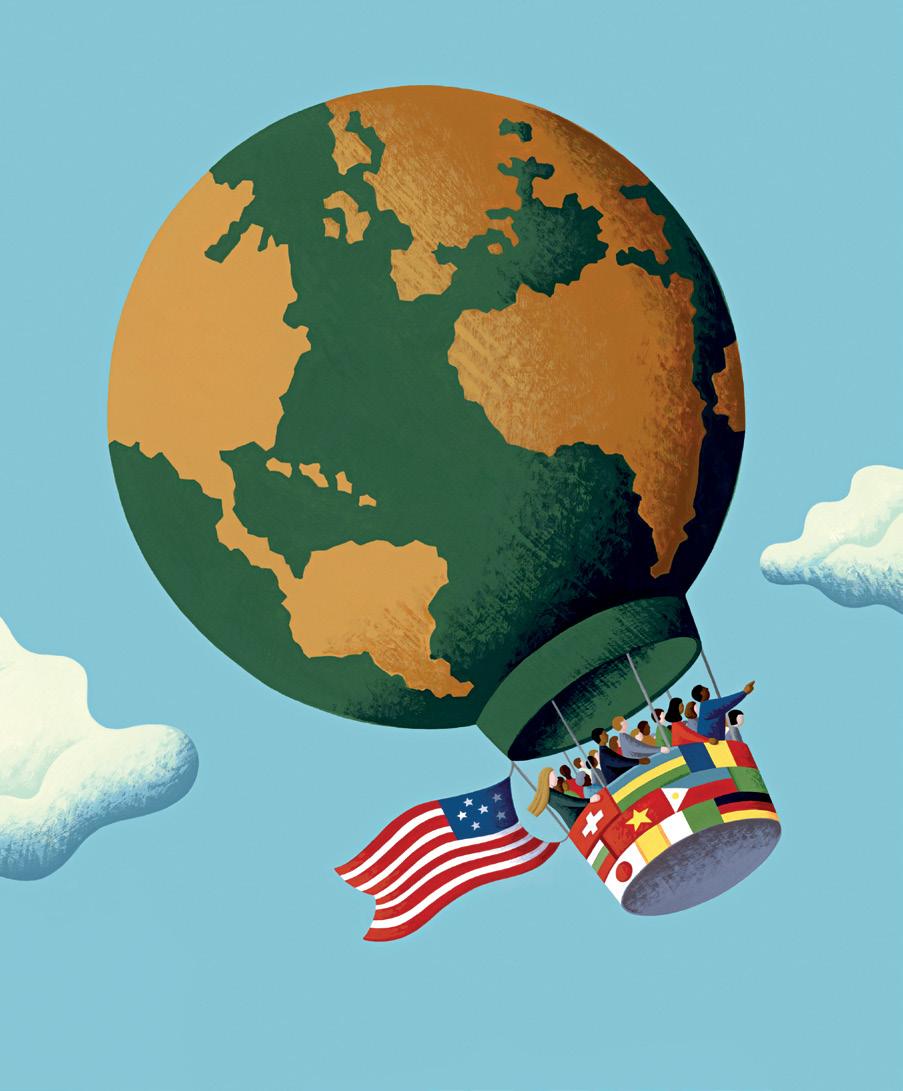
 BY JACKIE SWIFT
BY JACKIE SWIFT
Cataracts are the leading cause of blindness worldwide, according to the Centers for Disease Control. At the same time, a 15- to 20-minute cataract surgery can restore eyesight by the next day. But while cataract surgery is common in the United States, it is hard to come by in many countries.
“Cataract blindness is a huge issue, particularly in developing countries,” explains ophthalmologist Dr. Alan Kozarsky ’74, one of the leading vision correction specialists in the U.S. Kozarsky is an expert in front-of-theeye surgeries such as cataract procedures, and for more than 30 years has been carrying out medical outreach missions to Honduras.
“Cataract surgery is one of these really amazing pocket miracles in medicine,” he says. “You can change someone’s life in minutes.”
Kozarsky is a BoardCertified Ophthalmologist specializing in refractive (LASIK/related procedures), sports and performance vision, and consultative ophthalmology. He holds a B.S. from Hobart and earned his M.D. from the Albert Einstein College of Medicine. He completed residency training at Albert Einstein College of Medicine and his fellowship training at Emory University. He has practiced with Eye Consultants of Atlanta since 1987.
In Honduras — one of the poorest countries in the Western Hemisphere and among the most violent in the world, according to the United Nations — access to healthcare varies widely by socioeconomic status and proximity to urban areas; doctors are in short supply.
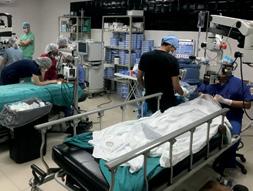
Kozarsky first learned about the medical need in Honduras in the early 1990s when a colleague at Piedmont Atlanta Hospital, Steve Wilkes, shared his own medical outreach experiences there. Soon, Wilkes was returning from Honduras accompanied by eye patients for Kozarsky to treat in Atlanta. “We did that for a few years,” Kozarsky remembers. “And then I said, ‘I probably should pay them a house call now.’ And that’s how I got started going to Honduras.”
As a student, Kozarsky had learned to pilot planes with the Hobart Flying Club. Over the years, his interest and skill only grew, and by the time he was leaving for Honduras, he not only had his pilot’s license but his own small
plane. Flying himself and his team meant “[we] could get on the ground quickly…. Honduras was close by small plane and that made it all very doable and really increased the yield of our missions.”
At first Kozarsky and his team carried out a few surgeries in remote parts of the country, but eventually they realized they could have greater impact if they worked with an established eye facility. That morphed into closer work with Honduran doctors, with Kozarsky’s team sharing techniques to increase efficiency and levels of care. “Our end game was to get to the point where they wouldn’t need us anymore,” he says. “They would be able to do this on their own, every day, yeararound. It’s about sustainability. It’s about scalability. If you can change one life with cataract surgery, why not change thousands?”
Over time, the program improved even more as Kozarsky and his colleagues connected
with the social entrepreneurship program at Emory University, which helped them grow the eye clinic facility in Honduras, and with Wake Forest University’s medical outreach program, which offers training to Honduran doctors.
“Our little program in Honduras has turned into the largest provider of cataract care in the country,” Kozarsky says. “They perform thousands and thousands of these operations without our help now.”
Even though he’s not needed like he once was, Kozarsky returns to Honduras every year to perform surgeries and keep connections with local partners strong. “Doing global health care is very complicated,” he says. “You need the support of the locals. You need to learn the landscape and make sure you’re helping the people who need it the most. You have to listen to the medical people there. They can help you find the most needy and deserving and underserved in their country and help you have the most impact. It’s amazing how much you can help humanity that way. There’s nothing that feels better.”
Looking back, Kozarsky says: “At Hobart I learned how to fly. And at Hobart, I learned how to go to medical school. So there are the seeds for the whole thing.”
Inspired by her Peace Corps service, LISA THORPE NICHOLS ’96 is driving public health research at the Yale School of Medicine that uses data to connect people with the care they need.
 BY ANDREW WICKENDEN ’09
BY ANDREW WICKENDEN ’09
It started in Madagascar. Nearly a decade after she left Hobart and William Smith, Lisa Thorpe Nichols ’96 volunteered for the Peace Corps, which brought her to the island nation. Though her assignment was focused on the environment, she initiated a wide range of projects and in helping the community thrive, found a calling in public health.
Despite the initial shock when she arrived, Nichols settled into the village and “fell in love with being there, with the people and working alongside them on that level.” ▶ (continued)
“
Doing global health care is very complicated. You need to learn the landscape and make sure you’re helping the people who need it the most.”
During her two-year service, she secured community development grants for solar panels for the village’s clinic and helped build latrines for the school. She identified sustainable economic opportunities using local produce and organized an educational fair, which created a foundation for longterm behavior change by increasing awareness on how rapid population growth places pressure on natural resources. She also worked with area healthcare providers to support maternal-child health.
Nichols says the sum of those experiences abroad taught her lot about the nature of service work and about helping people. As she puts it, “There’s a lot of work to be done. There’s always a need.”
When she returned to the U.S., Nichols joined a research project team at the Yale University School of Public Health which sought to understand the influence of residence on risk and injection-associated diseases. She learned phlebotomy and interviewed injectors to learn socio-demographics, mental health, injection risk, and their interactions with healthcare, harm reduction and criminal justice systems. Professionally, the position “opened a lot of doors for me,” she says, but it was also “one of my favorite jobs because I like working with vulnerable groups.”
Now a program manager for the Yale School of Medicine’s AIDS program, Nichols is part of a small team studying and building resources for people living with HIV/AIDS and managing other diseases, such as hepatitis C and addiction. Nichols’ current project uses Data to Care methodology, a public health strategy that harnesses health data to identify people with HIV who are not in care and link them to medical and social support.
“It’s all about data — where the burden of infection is, the demonstrated need,” Nichols says. Working with seven state, regional and municipal health departments across the country, she and her colleagues use aggregated health data to create and disseminate tools that enable health departments and clinics to track their progress reaching and treating people living with these diseases.
Enabling public health officials to identify “the gaps and challenges in their jurisdictions in terms of policy and barriers…does make an impact,” Nichols says. “You can see the increases in cure rates.”
Sustaining research and outreach at this scale is rife with funding and staffing challenges, not to mention the volume of data, and it could be easy to get lost in the numbers and logistics. But for Nichols, the Peace Corps experience is a touchstone reminder that helping people is “where my heart is.”
Nichols holds a B.A. in cultural anthropology at Hobart and William Smith and a master’s in public health from Southern Connecticut State University. Her work has been published in peer-reviewed journals such as AIDS Behavior and Journal of Acquired Immune Deficiency Syndromes.
Kathryn Lamardo ’13 spent five years as a cryptologic warfare officer in the U.S. Navy, specializing in moving intelligence swiftly, securely and properly through the chain of command from locations across the globe. Supporting freedom of navigation and strategic international partnerships, Lamardo’s service took her from Maryland to the South China Sea to the Persian Gulf, managing the flow of vital foreign intelligence while simultaneously safeguarding U.S. operational information from bad actors.
After she joined the Navy and completed officer candidate school in 2018, Lamardo’s first permanent duty station was at the National Security Agency in Maryland. Her experience there on the cyber watch floor supervising cyber operations prepared her for a seven-month deployment aboard the USS Essex.
Deployed to the Middle East and the West Pacific, Lamardo was responsible for the ship’s special security program, maintaining 175 top secret security clearance profiles on Navy and Marine Corps servicemembers to retain readiness of the force throughout the deployment. She also managed the ship’s operational security program, and this was no small task considering the ease and speed at which technology connects the world; it was Lamardo’s job to ensure information did not fall into the wrong hands.
“If acquired by malicious actors,” she explains, “classified and sensitive information could jeopardize the lives of service members and result in exceptionally grave damage to national security. However, the practice of safeguarding this information must be properly balanced with effective information sharing among the intelligence community. My daily work in the Navy revolved around ensuring that these practices were executed effectively for the sake of national defense.”
Aboard the USS Essex, Lamardo managed 11 sailors while producing hundreds of intelligence reports and executing real-world information operations. When the ship performed combined exercises with the Navy, the Marine Corps and the Japan Maritime Self-Defense Force in the Philippine Sea, Lamardo stood Information Warfare Commander watch, leading exercises in counter-intelligence,
counter-surveillance and counter-reconnaissance tactics with other participating ships.
Her deployment also included movements through the Strait of Hormuz, a contentious area in the Persian Gulf bordering Iran and Oman. These transits were not only necessary for their operational tasking but to ensure both safety and freedom of navigation in international waters. Lamardo’s signals intelligence team directly supported these operations by providing indications and warnings of immediate threats to the ship.
“It was clear to me that every single individual on the ship was working toward a greater goal,” says Lamardo. “We could not achieve anything without all of the pieces working together. Everyone, regardless of rank or department, played a key role in the success of the ship’s missions.”
She says the multi-dimensional education at HWS broadened her view of the world and developed communication and leadership skills that have served her well in the military. “My diverse class experiences at HWS, the discussions, the people and the courses prepared me to lead such a diverse group of people,” she says.
Public service has always been a passion for Lamardo, with her father serving in law enforcement and extended family in the military. After graduation, she worked for a private chemistry company and then spent almost three years as a criminalist for the New York City Police Department. Her time in the Navy allowed her to combine tactical expertise to work with service.
As she says, “being a member of that problem-solving team [of naval officers and sailors] was deeply gratifying.”
A chemistry major with minors in economics and dance, Lamardo completed her U.S. Navy service in December 2022. As she prepares to start an M.B.A. program at Columbia Business School, she is currently interning with a financial firm to explore the different opportunities in the private sector but can’t rule out a return to public service in the future.

“If acquired by malicious actors, classified and sensitive information could jeopardize the lives of service members and result in exceptionally grave damage to national security.
Around the world, U.S. diplomats serve as mediators and interpreters on the frontlines of foreign policy. For David Luna ’14, a political reporting officer in the U.S. Foreign Service, the key is “to be as plugged in and as connected as possible on the ground, because you’re only as good as your information.”
“We constantly have our finger to the wind,” says Luna. “We’re meeting civil society and government leaders, cultivating relationships and informing Washington policymakers on breaking events and developing trends.”
All of that work, he says, supports the position of the U.S. “in a strategic competition to shape the future of the international order. Diplomacy tries to answer the demand for increased global cooperation.”
be able to represent the U.S. and provide the best service I could.”
From Beijing, he moved to the U.S. Embassy in Ljubljana, Slovenia, serving as a political officer on civil society projects and strengthening the European security relationship. Now in Islamabad, Pakistan, he is again working in the political track, or “cone,” though in a much different context given the differences in population, geopolitical dynamics and diplomatic rapport.
Focused primarily on Pakistan’s relationships with China and India, Luna says there’s never a dull moment. “The portfolio is extremely fast paced,” he says, noting China’s footprint in Pakistan and the historical border disputes with India in the Kashmir region. Against this geopolitical and cross-cultural backdrop, “there’s always a web to untangle — you are finding and fitting a new piece of the puzzle, a puzzle that is always morphing and never complete. Part of the fun is hearing what one person thinks of a situation and then finding others who offer alternative observations.”
Not just a job or a career but a “lifestyle,” the Foreign Service means uprooting and moving around the world every 24 to 36 months.
Luna holds a bachelor’s in political science from Hobart, where he was a part of the Higher Education Opportunity Program, served as president of HWS Votes and initiated and organized a U.S. Congressional Debate, the first to take place at HWS. After receiving the Rangel Fellowship, he earned an M.A. from the Josef Korbel School of International Studies at the University of Denver.
Luna’s career with the State Department began in 2014, when he was awarded a Rangel International Affairs Fellowship through the State Department. After earning his master’s from the Josef Korbel School of International Studies at the University of Denver, he was assigned to the U.S. Embassy in Beijing, China.
In Beijing, Luna served as a consular officer, facilitating legitimate official, business, leisure and academic travel to the United States and in the process contributing to the American economy. The visa line serves as “one of the main interaction points that a local population can have with the State Department,” he explains, “so when we’re interacting with visa applicants our comportment, our integrity, our ethics are all very important. For many individuals I met in China, I was the first American they ever spoke to, so it was a joy to
“It can be difficult to say goodbye,” Luna says, and “being comfortable feeling uncomfortable” is a prerequisite, but he likes the regular change. “You’re a lifelong learner — always learning a new language, new issues, dealing with new people.” There is space for all personality types in the Foreign Service, says Luna. What has worked for him though is being able to connect, to read the room and read people.
A self-described “people person,” Luna recalls that what he loved about his time at HWS was the relationships with faculty. With a shout out to his advisor, Professor of Political Science
DeWayne Lucas, Luna says: “I’m someone who likes to connect, and I always felt that I could walk into any professor’s office and talk about course material but also about life.”
Likewise, individual relationships are the foundation of international cooperation. “Never underestimate the power of a single conversation, which can bridge gaps, leave lifetime impressions, and especially in the case of diplomacy, reassure and build trust,” Luna says.

“
Never underestimate the power of a single conversation, which can bridge gaps, leave lifetime impressions, and especially in the case of diplomacy, reassure and build trust.”
 BY PAIGE COOKE
BY PAIGE COOKE
“Intellectual property is a huge economic driver,” says Meghan Donohoe ’92. “If you don’t have a way to protect your innovation, there is no longer an incentive to innovate.”
For the past 22 years, Donohoe has served as the chief operating officer for the American Intellectual Property Law Association (AIPLA). AIPLA is a voluntary bar association that supports intellectual property professionals involved in the practice of patent, trademark, copyright, trade secrets and unfair competition law, as well as other legal structures involving intellectual property. The association provides continuing education for its members, who are predominately in the United States, but advocacy efforts stretch around the globe, attempting to strike a balance between international public and private interests.
“The Intellectual Property system is closely tied to the success of the economy in the United States and around the world,” says Donohoe. “It is evolving and changing. With these new challenges, the education and policy work is so important.”
AIPLA’s members focus on both prosecution and enforcement of IP rights. Prosecution entails working with inventors and creators to obtain patents and trademarks and helping them register copyrights. The enforcement side involves litigators who represent inventors and creators in protecting their intellectual property. In addition to education, the association focuses on advocacy and policy issues to support and advance the intellectual property system, supporting and resourcing attorneys in their work, and in turn spurring innovation.
Innovation, Donohoe notes, comes with intellectual property hurdles, some longstanding, some brand new. Curbing counterfeit products is an age-old challenge, while newly developed technology, such as artificial intelligence, presents emerging policy questions. (Can AI be credited as an inventor? Most countries say no.)
AIPLA’s global work brings people in the intellectual property space together. As nearly every country has its own intellectual
property laws in place, the advocacy of Donohoe and her colleagues focuses on harmonizing these systems, bring various players together to better understand each other and to stimulate new ideas and collaborations across the globe.
This spring, the AIPLA teamed up with the U.S. Patent and Trademark Office and other organizations to celebrate World Intellectual Property Day, with an emphasis on “amplify[ing] the role women play in the field of intellectual property,” Donohoe says. “To have movement internationally on raising the profile of women in the field is so important. Working to build equity and reduce the gender pay gap are important challenges we are facing. Women can and are succeeding in this space.”
Donohoe notes that between her colleagues and the global impact of their work, “We all see the value of intellectual property and the way it ties to creativity and innovation all over the world. It is very motivating to come together to do the work to continue to strike that balance for both the public and private interests.”
Donohoe holds a bachelor’s in economics and Russian area studies from William Smith and an M.A. in Russian area studies from Georgetown University, with a focus on economics, politics and language. She previously served as director of the Roscoe Pound Institute (now the National Civil Justice Institute).
Where is the world headed in five years? USAID Senior Foresight Advisor STEVEN GALE ’69 is helping the federal government plan for the likeliest scenarios.
 BY ANDREW WICKENDEN ’09
BY ANDREW WICKENDEN ’09
Steven Gale ’69 is in the business of the future — not predicting it so much as forecasting several possible trajectories. As Senior Advisor at the U.S. Agency for International Development (USAID) Bureau for Policy, Planning and Learning, Gale leads efforts to examine the confluences of global events and drivers of change likely to impact U.S. foreign policy in the future, with a lens on international development. With colleagues and counterparts from other government agencies, think tanks and international organizations, he studies possible scenarios to help highlight implications for current aid programming to address a rapidly changing, increasingly uncertain and highly interconnected world. Wherever the U.S. is investing around the globe, Gale is looking at trends in areas like demography, urbanization and education, and keeping a pulse on emerging “signs and signals” that may influence the development landscape in the next five to 10 years. ▶ (continued)
“
The Intellectual Property system is closely tied to the success of the economy in the United States and around the world.”
Since 1961, USAID has supported programs as diverse as health, economic development, democracy, education and natural resource management in more than 100 countries. Among the most important emerging challenges, Gale argues, is in energizing young people around democratic engagement.
Global freedoms “are in a free-fall,” as Gale wrote in a 2022 blog for the Wilson Center, the nation’s key non-partisan policy forum for tackling global issues. Recent reports, he notes, indicate that “less than half the world’s population today lives under some form of democracy,” while democracies themselves “are now facing their biggest challenges since the 1930s and increasingly disappointing many global citizens.” Central to these challenges, Gale says, is “the growing disillusionment of today’s youth, even in democratic countries.… [U]nless we can do a better job to engage these youth, the stakes for democracy are high.”
As Gale explains, this disengagement suggests that young people “don’t have a high level of confidence or trust in existing economic, political or social entities. They may also want to ‘opt out’ because they perceive that their generation is not being heard or treated fairly.” Whatever their reasons, this disaffection can ripple out into the large social sphere, impacting “well-being and mental health…and individual and country-level economic productivity and quality of life.”
Programs like USAID’s Global LEAD are trying to get ahead of these trends, with increased investments in leadership development, education, and civic and political engagement. But, Gale says, keep in mind that “our programs don’t happen overnight. If you’re equipping schools in Africa or repairing the electrical grid in Ukraine, you have to think long term.”
The challenge, he notes, is that such long-term planning often runs counter to the human tendency to think short-term. Another misperception is “to think the future is going to look like the past.”
“If youth are disaffected today, that’s going to undercut democracy down the road,” he says, “so if you’re only looking in the rearview mirror at past problems, you will not be able to address the challenges of tomorrow. The idea is to peer into the future to make sure that what we’re doing now will make sense five and 10 years out.”
Gale has worked for USAID since 1992, serving in the Agency’s Bureau for Policy, Planning and Coordination and Bureau of Legislative and Public Affairs. He has served as a Senior Advisor on Human Security at the National Intelligence Council, Director for Afghanistan at the National Security Council, and a Brookings Legislative Fellow for the House Oversight Subcommittee on National Security. He holds a B.A. from Hobart, an M.A. from Brooklyn College, and a Ph.D. from the CUNY Graduate Center. He was a postdoctoral Fellow at Columbia University and the National Institutes of Health.
Beyond the classroom, students and faculty are putting into practice the knowledge, perspectives and insights of global studies. Alongside ever-evolving study abroad opportunities, campus events like the Anderton Forum for Global Engagement and programs such as Technos International Week cultivate an informed and engaged community of global citizens.
For more than 25 years, Technos International Week has been a core component of global education at HWS. Thanks to the generosity of the Tanaka family and the Tanaka Memorial Foundation, students and faculty have participated in an intensive annual language and cultural exchange summer program in Japan. In 1992, gifts from the Tanaka family and the Tanaka Memorial Foundation established the Tanaka Asian Studies Endowment and have since supported the Asian Studies Program and the Tanaka Lectureship in Japanese, as well as student internships and faculty research projects with an emphasis on Asia. This summer, Professor of Theatre H May is leading HWS students to Tokyo for Technos International Week. The partnership also brings students from Technos International College to the U.S. Above, HWS and Technos students visit Sonnenberg Gardens in Canandaigua.

During the inaugural Anderton Forum for Global Engagement, former U.S. Ambassador to Ukraine Marie Yovanovitch shared insights from her 33-year career in the U.S. Foreign Service and the lessons and values she learned from her immigrant parents, as well as key calculations around the war in Ukraine.
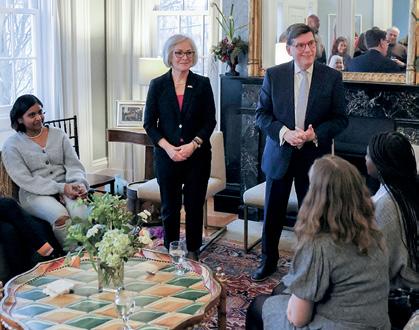


Each year, the Kinghorn Global Fellowship recognizes a faculty member who exemplifies global citizenship. As the 2022-23 fellow, Professor of Spanish and Hispanic Studies May Summer Farnsworth pursued the research, interdisciplinary collaborations and internationally oriented community engagement that characterizes her global scholarship. Pictured above with students during in the 2019 summer abroad program to Quito, Ecuador, Farnsworth has previously directed study abroad programs to the Dominican Republic, Chile and Ecuador, and in the fall will lead students to Sevilla, Spain.

“There’s no question that the war in Ukraine is about Ukraine,” she said, but it will continue to have far-reaching geopolitical impacts. Yovanovitch noted that if, for instance, the conflict is “not settled in a way that China understands that we mean business,” China will “take the wrong lessons…. The bottom line is that it’s better for the U.S. to stop Russia in Ukraine than to have to stop it later at a time not of our choosing and that may not be to our advantage.”
Established in 2022 by former Trustee James F. Anderton IV ’65, the annual forum brings renowned experts to campus to share their insights and experience while engaging with the HWS community on vital current affairs in international relations. The forum, which is overseen by the Institute for Global Studies faculty and the Office of the Provost, supports the global studies curriculum and the broader campus community’s engagement in global events.
Revisit the inaugural Anderton Forum event.
International Relations and French and Francophone Studies double-major Johanna Golden ’23 spent last fall in Tunisia, improving her French and Arabic and working on a project supporting female entrepreneurs. Through the Student International Initiatives Fund, which awards grants for study abroad projects, she also found an opportunity to practice her language skills while studying traditional Tunisian dance, which she says “immersed me into the culture here in a different and more profound way.” Golden will return to North Africa this fall as a Peace Corps volunteer in Morocco.
 ▼ President Mark D. Gearan introduces former U.S. Ambassador to Ukraine Marie Yovanovitch during a gathering at his home before the Anderton Forum.
PHOTO BY KEVIN COLTON L.H.D. ’23
▼ President Mark D. Gearan introduces former U.S. Ambassador to Ukraine Marie Yovanovitch during a gathering at his home before the Anderton Forum.
PHOTO BY KEVIN COLTON L.H.D. ’23


At Commencement, HWS celebrated graduates as well as the achievements of honorary degree recipients who have devoted themselves to enriching HWS and the communities around them.
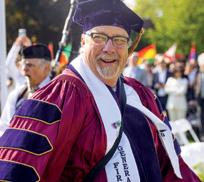

In his Commencement address, social entrepreneur Alan Khazei L.H.D. ’15 praised the passion of Hobart and William Smith graduates — members of the “world’s first global generation and most socially and politically active since the 1960s.”

“I started City Year because I deeply believe in the power of young people like you to change the world,” said Khazei. “Your passion and leadership can bring us to a fairer, equitable, inclusive and just America and world. We need you to do that…. I believe that Hobart and William Smith has prepared you well and I cannot wait until your generation is in charge.”
During Commencement, HWS awarded honorary degrees to four individuals who represent the values and ideals of Hobart and William Smith including: Patricia L. Adams, a successful corporate professional, musician, journalist, steadfast friend of the Colleges and daughter of Hobart’s first Black graduate, the Rev. Dr. Alger L. Adams ’32, D.D. ’83; Dr. Gilberto Arbelaez ’06, the only emergency physician on staff at Uvalde Memorial Hospital who treated victims in the immediate aftermath of the 2022 school shooting in Uvalde, Texas; Cynthia Gelsthorpe Fish ’82, a longtime member of the Board of Trustees who has advanced the Colleges’ efforts in governance and leadership and has been active in causes related to health, wellbeing and education; and Kevin Colton, Hobart and William Smith’s longtime lead photographer who has brought campus to life with his unique perspective.
When Gilberto Arbelaez, MD, arrived for his shift at Uvalde Memorial Hospital on May 24, he hit the ground running as usual. Though Uvalde, Texas only has 15,000 residents, Memorial has an emergency department that stays busy. That morning, Dr. Arbelaez had already managed a flash pulmonary edema patient who required intubation and diagnosed a thoracic aortic dissection. He was on the phone with specialists in San Antonio, trying to transfer these patients out for further care, when he heard the security guard’s nearby radio: “Gun shots fired.”
Then, hospital staffers started getting phone calls and texts as word spread through the small town: The shooting is at the elementary school. Someone who was shot in the face is being flown out to San Antonio. This is real.
Dr. Arbelaez and his team kicked into preparation mode. The hospital floors were being refinished that morning, so the emergency department had been temporarily relocated to a different, smaller area of the hospital. The flooring crew was dismissed, and everyone worked urgently to return the emergency department to its optimal setup. Some of the staffers worked to quickly discharge non-emergent patients, as the rest of the team gathered
extra beds, intubation trays, chest tubes, and tourniquets.
And then, they waited. “It seemed like it took forever,” Dr. Arbelaez said. He felt a sinking dread as the minutes of trauma’s golden hour ticked away, the emergency department still empty. Never before had he wished for more patients in his emergency department. Finally, they got the call from EMS that their first patient was en route.
“Everybody was gowned and gloved. Lines were primed, everything was ready,” Dr. Arbelaez said. “We were waiting for the ambulance to arrive in the emergency entrance when all of the sudden, we heard shouting from the lobby. For some reason the ambulances decided to bring the patients through the main doors.”
They turned in unison and looked down the hallway to see two young girls being pushed toward them on gurneys. Dr. Arbelaez and the general surgeon received the first child who was in dire condition. “[The surgeon] did a cut to try a pericardial window, and there was no bleeding from her skin whatsoever,” Dr. Arbelaez said. “She was completely exsanguinated by the time she got to us.”
Next came a child shot in the shoulder and buttocks. Then a teacher with gunshot wounds in the arm, chest, and back. Then another young girl who had been shot in her chest, arm, and
hand. A boy arrived, already covered in a white sheet. He was taken to the only space available for the deceased— the hospital chapel.
Dr. Arbelaez evaluated a young girl who had taken a ricocheting bullet to the face. It entered her right nostril and lodged in the upper left portion of her nose. She wasn’t bleeding, wasn’t even crying, and had only minimal associated fractures. For Dr. Arbelaez, viewing her scan was one of the few moments of relief during a day of horror. He shook his head and thought back to viewing her scan: “Millimeters in another direction and it could have killed her.”
Dr. Arbelaez, the only emergency physician on staff that day, and his small emergency care team of one physician assistant and a few nurses were joined by family physicians and a pediatrician, who took the lower acuity patients, and a radiologist with a portable X-ray machine who helped read scans as quickly as possible. Off-shift staff who heard the news dropped everything to come help at the hospital.
The Southwest Texas Regional Advisory Council (STRAC), designated by the Texas Department of State Health Services (DSHS) to develop, implement, and maintain the regional trauma and emergency health care system for more than 26,000 square miles in southwest Texas, helped Uvalde Memorial coordinate transfers of patients to associated hospitals in San Antonio, including University Hospital, San Antonio Military Medical Center, and Methodist Children’s Hospital.
As they worked, the members of the medical team—some of whom had children and grandchildren at the school—were hearing bits and pieces of information: The shooting has ceased. No, shots are still being fired. Kids are calling for help on cell phones. They’re pulling them out of windows. Kids are running away barefoot because they were making paper maché shoes … The uncertainty was excruciating.
As the only emergency physician on staff at Uvalde Memorial Hospital after the tragic shooting at Robb Elementary School, Dr. Gilberto Arbelaez ’06, Sc.D. ’23 led the emergency care team in treating victims.Dr. Arbelaez could see his colleagues had tears in their eyes, but they stayed focused. “They never lost their cool,” he said. “They never complained. Everyone just kept going.”
Dr. Arbelaez has a five-year old daughter, and he kept imagining himself in the same situation as the Robb Elementary parents. He clicked into an “emotionless” state to cope with the horror of the situation and to continue providing his best care to the victims. “I’m not sure if that’s the best way to put it, but I felt if I put any kind of emotion into it, I’d just be frozen and not be able to do what I’m supposed to do.”
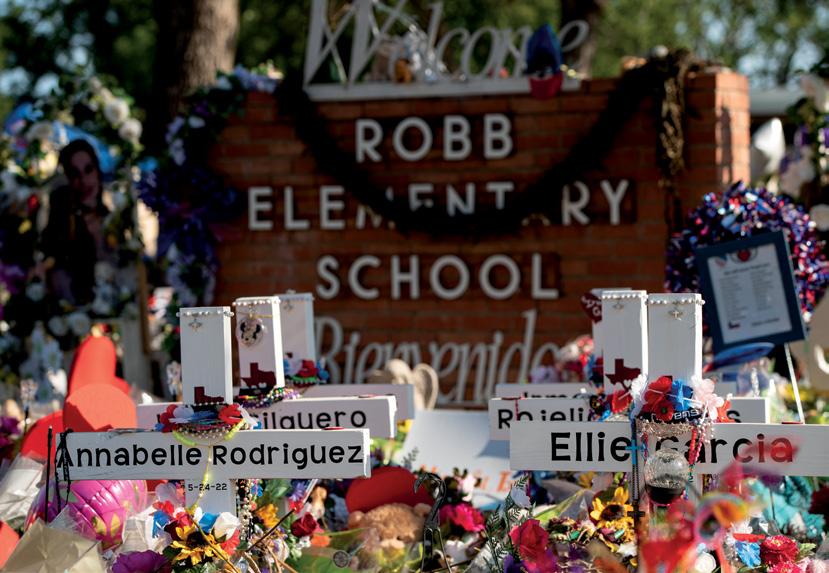
As the pace began to slow and the health care professionals finally were able to take a deep breath, the emotions came in waves. It wasn’t until 6 p.m. when Dr. Arbelaez was dictating the charts for the 20 victims they received, that the gravity of what he had witnessed began to sink in. “I was like, my God, look at all these bullet wounds and lacerations and mangled arms and mangled hands,” he recalled. He kept flashing back to that moment in the hallway when they turned around to see the first child being rushed through the lobby by EMS, but she was already gone.
At the end of their shift, the medical team gathered outside the ambulance bay to talk about what they had just been through together. They spent 10 minutes talking through the scene, the preparation, and their response. Team members shared how they were feeling and expressed gratitude for every member of the team. They hugged and cried and had a moment of silence for the
▲ The memorial at Robb Elementary School in Uvalde, Texas following the 2022 mass shooting, whose victims where cared for by Dr. Gilberto Arbelaez ’06, Sc.D. ’23.victims. Taking a moment to pause and reflect “was helpful for everyone,”
Dr. Arbelaez said.
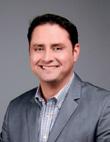
In the days that followed, Dr. Arbelaez worked his string of day shifts as planned. He felt staying busy was his best option. “Very few people outside of work understand what we go through,” he explained. He said it was therapeutic to be around his colleagues who were there that day. While they lean on one another as needed, Dr. Arbelaez and his coworkers are also receiving counseling to help them process and cope.
In addition to helping coordinate hospital transfers during the initial crisis, STRAC sent mental health professionals to help staff and local first responders process their trauma. The organization deployed extra health care workers to Uvalde in the weeks after the tragedy to relieve the usual emergency department (ED) team members who needed to rest and recharge.
Uvalde is a close-knit community where “everyone has only two degrees of separation,” Dr. Arbelaez said. And if everyone is connected, everyone is sharing this pain. He thinks it’s too soon to know how much this trauma will impact those involved, but he knows the anguish is acute and widespread.
“We’ve seen multiple parents coming in with anxiety,” he said. “It sort of relives everything again, right? Because then you put a face to the parents who were searching for their kiddo. They’re anxious and distraught and there’s nothing, nothing I can say or do to help ease their pain and grief.”
For his part, Dr. Arbelaez sometimes wakes up in the middle of the night, his mind racing through different aspects of the tragedy.
He thinks about the stoic looks on the kids’ faces as he took care of them that day. “These kids did not cry at all—the kids who got shot,” he said. “They came
in scared, but I didn’t see a single tear in those kids, not a single one.”
He thinks about how his training prepared him for this day. Dr. Arbelaez is grateful that he had mass casualty training during his emergency medicine residency at the University of Connecticut. “I had a moment after all of this where I thought, ‘Imagine if I had not trained at a Level I trauma center?’ I’m just glad I had the tools and the staff to be able to save a couple lives that otherwise wouldn’t have been saved.”
He thinks about the way the Uvalde Memorial ED staff responded to the shooting. “[That hospital] has one of the most efficient and cohesive teams I’ve ever worked with,” he said. His team was ready and waiting, but what if they didn’t have to wait so long? Could they have saved more lives?
He thinks about school shootings. He was in high school when Columbine happened. He was an emergency medicine resident in Connecticut when 26 people were killed at Sandy Hook Elementary. And now this. “It feels like no kiddo is safe,” he said.
And Dr. Arbelaez thinks about his own child. Her safety, her future. He remembers how the first two victims reminded him so much of her.
“We [emergency physicians] like to fix things … it’s just kind of the way
we’ve been trained and sort of our personalities,” he said. “I just don’t know why we can’t fix this problem. We’re the most advanced country in the world, and we can’t get out of this hole.”
Dr. Gilberto Arbelaez ’06 is an emergency medicine specialist with expertise in diagnosing and treating patients with life-threatening conditions from heart failure to drug overdose to traumatic injury. A first-generation college student, he was a pre-med biology major at HWS and went on to earn his M.D. from the University of Connecticut School of Medicine, where he completed his residency and received masscasualty training.
In 2023, Hobart and William Smith awarded him an honorary doctorate for his exceptional bravery and steadfast, lifesaving work as a physician.
©2023, American College of Emergency Physicians, Reprinted with Permission.
“We [emergency physicians] like to fix things ... it’s just kind of the way we’ve been trained and sort of our personalities. I just don’t know why we can’t fix this problem. We’re the most advanced country in the world, and we can’t get out of this hole.”
On campus this spring, head of Scout Motors Scott Keogh ’91 reflected on the future of the automotive industry.
Scott Keogh ’91 has sharpened branding, boosted sales and produced groundbreaking marketing campaigns for luxury automakers, including Mercedes-Benz, Audi and Volkswagen. Now, as President and CEO of Scout Motors, Keogh is leading the allelectric truck and SUV startup backed by the Volkswagen Group.
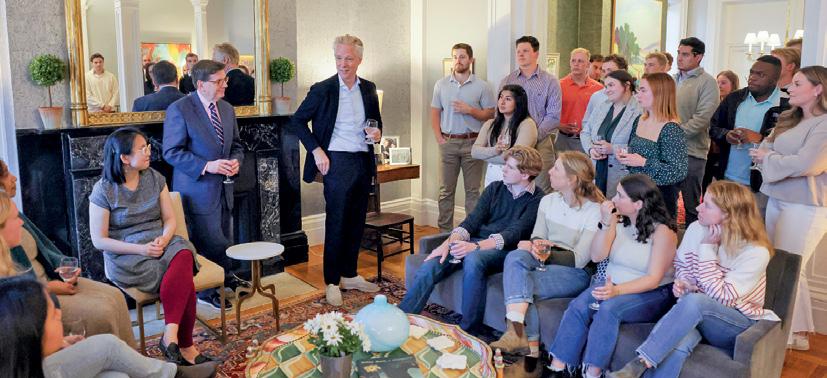
During his President’s Forum conversation with the HWS community, Keogh noted that automobile electrification is “one of the single biggest industrial transformations” and “[it’s] happening in America as we speak.”
Into that frontier enters Scout, a contemporary update of the classic International Harvester utility vehicle.
With regulations targeting increased fuel efficiency and electric vehicle production, as well as the investments in microchip and battery plants through the Inflation Reduction Act, Keogh sees a huge opportunity for the new company, which is set to launch in 2026.
“Heritage meets ingenuity,” he said, succinctly describing the brand’s ethos and consumer appeal. “We think there is a possibility for an authentic, really physical connection. We feel we can make a car that can do it. Yes, it’s got a little bit of nostalgia to it, but of course we are bringing it into the future and modernizing it.”
▲

In June, hundreds of alums and families returned to campus to reconnect and celebrate. The weekend included the annual parade of alums, a State of the Colleges Address by President Gearan, the Distinguished Faculty Award ceremony, classes with current and retired faculty, a panel on Tommy the Traveler and a barbecue and fireworks finale on the Quad.




 MORE PHOTOS
1. Pietro del Fabro ’67, who led the effort to restore the stainedglass windows in the Blackwell Room, offers his reflections at the dedication ceremony.
2.Members of the Classes of 1972 celebrate the dedication of the Outdoor Classroom.
3. Alums parade down Pulteney Street.
4. Alums on the Quad with the Reunion fireworks display overhead.
5. During the Alumni and Alumnae Associations’ Distinguished Faculty Awards presentation, President Gearan welcomes this year’s recipients: Associate Professor Emerita of Economics Jo Beth Mertens and Professor Emeritus of Biology Thomas J. Glover.
MORE PHOTOS
1. Pietro del Fabro ’67, who led the effort to restore the stainedglass windows in the Blackwell Room, offers his reflections at the dedication ceremony.
2.Members of the Classes of 1972 celebrate the dedication of the Outdoor Classroom.
3. Alums parade down Pulteney Street.
4. Alums on the Quad with the Reunion fireworks display overhead.
5. During the Alumni and Alumnae Associations’ Distinguished Faculty Awards presentation, President Gearan welcomes this year’s recipients: Associate Professor Emerita of Economics Jo Beth Mertens and Professor Emeritus of Biology Thomas J. Glover.

From academics to guaranteed internships to scholarships, every aspect of the student experience is enhanced thanks to Annual Fund giving, including the inaugural Scholarship Day of Donors, which topped $650,000.
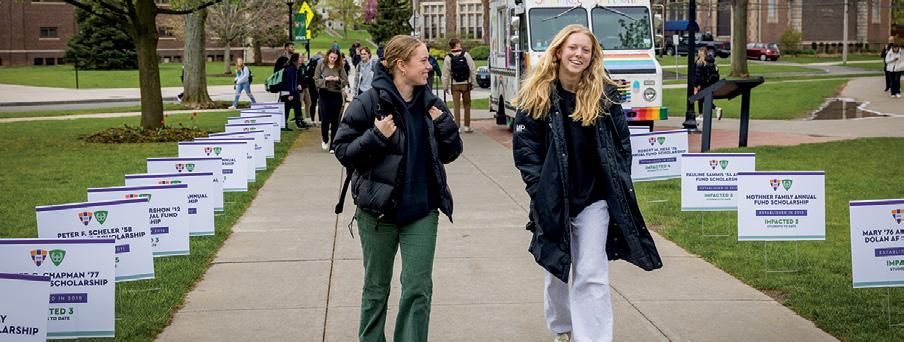
This spring, the HWS community came together for a record-breaking 24 hours of fundraising in support of scholarships, tallying the most Annual Fund support in a single day. Alums, parents, faculty, staff, students and friends gave more than $650,000 toward Annual Fund scholarships. In the fall of 2023, up to 125 students will receive a Scholarship Day of Donors Annual Fund Scholarship
thanks to the support of everyone who gave during the challenge.
The fundraising total includes a challenge gift of $50,000 from John A. Manley ’64, P’93, which matched the first $50,000 raised dollar-for-dollar, as well as a challenge from Charles and Carolee Jones P’18, P’22, providing an additional $50,000 when the donor goal was achieved. In total, the day saw $651,418 given by 554 donors, reaching 110 percent of the donor goal.
You can help more students by making a gift to the Annual Fund for Hobart and William Smith today.
A principal investigator and senior research associate at Harvard’s Project Zero, Carrie James ’92 returned to campus this spring to participate in the President’s Forum Series and discuss her recent book, Behind Their Screens: What Teens are Facing (and Adults are Missing). Here, she breaks down six common misconceptions about social media and technology — and the complex social and emotional stakes teens are managing.
The obsession with screentime misses important context.
“A lot of public discourse is about monitoring and minimizing screentime, but screentime is pretty limited as a measure of value and a crude way of helping kids in a complicated world. It doesn’t account for what they’re actually doing on their devices. An hour of browsing recipes or watching book reviews on TikTok doesn’t feel as detrimental or scary as an hour spent browsing friends’ Instagram highlight reels when you’re home alone. Also, teens are differently susceptible to the opportunities and risks of what they engage with in the media. Reactions to content will vary across teens and their interests, and in any given moment for an individual teen. Measures like screentime don’t get at those nuances.”
Rather than dulling compassion, tech can amplify it in unexpected, sometimes counterproductive ways.
“There’s a common idea that technologies undercut human empathy: when you’re communicating with someone in a mediated fashion, you can’t see their emotional responses; there’s the absence of tone; text conversations can be brusque. But we learned that empathy is a key reason why teens feel pulled to their screens — and that it can create big dilemmas for setting boundaries in a way that preserves friendships. We heard a lot about the pressure they feel to comment on someone’s Instagram post immediately and to be sufficiently flattering and complimentary, especially for close friends. The stakes are higher when teens have friends struggling with mental health issues; they feel like they need to stay connected to save their friends, which can become overwhelming.”
>> In their book, James and Emily Weinstein draw on perspectives from more than 3,500 teens, combining stories and data to reveal what young people are up against — and what teens need adults to understand.
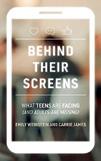
The political is interpersonal — and increasingly inescapable.
Cyberbullying is a problem, but there are subtler destructive social dynamics at play online.
“Adults tend to focus on explicit acts of aggression that are pretty unambiguous. There’s plenty of that online, but so much of what teens told us they struggle with looks benign or accidental to someone who doesn’t know the context, especially to adults. Going through someone’s feed and liking every post seems like neutral-to-positive behavior, but aggressive liking can send a message that “I’m watching you.” We heard about cropping someone out of a photo, or tagging every person in a photo except one. There’s more and more data that gives teens markers of their friendship status, of their popularity, of their relationships with others — all of these things are really important to their sense of self and identity. And they can check them around the clock.”

It’s not that teens don’t understand the risks; they’re navigating a fraught social landscape.
“Sexting is a spectrum. Adults tend to use just the one word, but it’s much more complicated: there’s consensual sexting in the context of a relationship; there are sexts shared without permission; there’s also the social pressure component, with boys feeling pressure to ask for nudes and girls feeling pressure to send them (these pressures play out in pretty gendered ways, though a lot of research still needs to be done regarding queer youth and teens along different parts of the gender spectrum). Effective interventions will look different in different sexting scenarios, but generally, teens want deeper conversations and practical, tactical skills for dealing with these situations. “
“In 2010 and 2012, we studied civically active teens and asked how social media was part of their civic participation. At the time, teens felt like they had a choice: if the tensions around posting about their civic commitments were too high, they would just go quiet on social media. In our most recent research, we heard from teens — both those who are civically active and those who aren’t — that they feel pressure to post about timely issues on social media, and that if they don’t, they’ll be judged by their peers. Some feel like it’s an important, productive space for sharing stories and perspectives, but there’s a sense of obligation to show they care and are alert to these issues, as well as an anxiety about the impact these posts actually have.”
Teens are adapting to the permanence of digital life.
“Teens are aware that content lasts forever. They live with this sense of risk, heightened by digital-footprint and internetsafety lessons from adults basically saying their lives will be ruined because of something they posted. In our past research, a big reason why teens who were civically active on social media went quiet is they felt that the risks of a politicized digital footprint were too high. Teens are figuring out ways to manage some of the risks though, making very intentional decisions about what they share with close friends, acquaintances and the general public (a lot of app features like private stories are helpful in this regard). Some friends also form social pacts to check in with one another for approval before posting. They’re recognizing that privacy is a social matter, not just about individual choice.”
CARRIE JAMES ’92 is a senior research associate and principal investigator at Project Zero. A sociologist by training, she explores young people’s digital, moral, and civic lives. With Emily Weinstein, she co-directs projects that engage teens as co-designers of interventions to support their digital well-being. James, who coauthored Behind Their Screens with Weinstein, is also the author of Disconnected: Youth, New Media, and the Ethics Gap. She holds a B.A. in sociology from William Smith and an M.A. and Ph.D. in sociology from New York University. She is the parent of two technology-loving kids, ages 13 and 17. Follow her on Twitter at @carrie_james.
Pre-med STEM Scholar
Summer researcher on family planning in Rwanda through Western Washington University
Member of Posse, Latin American Student Organization and Theta Phi Alpha sorority
Major:
Sociology
Hometown: Los Angeles, Calif.
memorable courses, healthcare insights and serving others across the generations
Who or what inspired you to study medicine? NS: My Tía Corrin, who is a nurse in El Salvador. I will always admire her, especially for taking care of my late grandfather while he was fighting skin cancer. KC: The Biology of Perception course at HWS, after childhood years reading Reader’s Digest articles such as “I am Joe’s heart.”
Favorite or most memorable course at HWS? NS: My Geoscience independent study on gender diversity and representation with Professor Arens. KC: The Anthropology class on kinship and family relationships with Russell Judkins.
Favorite place(s) on campus? NS: The Adams Intercultural Center, the library and the gym. KC: Houghton House.
How has your perspective as a nonSTEM major influenced your view of medicine? NS: The medical field can be disconnected from reality as it tries to find instant, simple fixes. But as I have learned and experienced, health issues are complex, affected by many aspects of one’s life. KC: My Anthropology major was of critical importance since I would have my whole life to study medicine but “only” four years of college to learn about and understand my patients’ different backgrounds.
What are some key global challenges regarding family medicine? NS: We must be aware of different practices, needs, cultures and experiences, as well as technical challenges: accessibility, affordability and simply having enough staff. KC: The widespread lack of access to basic health care, and the epidemics of infectious disease coupled with the lack of effective vaccines against malaria, TB and HIV/AIDS.
What are you most grateful for?
NS: Family, friends and mentors.
KC: My three healthy children and 47 years of a solid marriage.
Your most rewarding accomplishment?
NS: Becoming a Posse Scholar. KC: My trips to Afghanistan.
Best piece of advice you’ve received?
NS: Ask for help and seek out resources.
KC: From my dentist while I was home from college: “Go to medical school — you can do it!”
What motivates you? NS: Knowing that whatever I do will make my family proud. KC: To be of service to others and make the world a better place when I leave than it was when I arrived.
Family Practice Physician Volunteer in Afghanistan supporting maternal-child health M.D. from Virginia Commonwealth University, M.B.A. from University of Denver and M.P.H. in International Public Health from University of Washington
Major: Anthropology
Hometown: Bellingham, Wash.